BK Technologies DPHX51 VHF Transceiver User Manual DPH Owners Manual
RELM WIRELESS CORP. - BK RADIO VHF Transceiver DPH Owners Manual
Manual
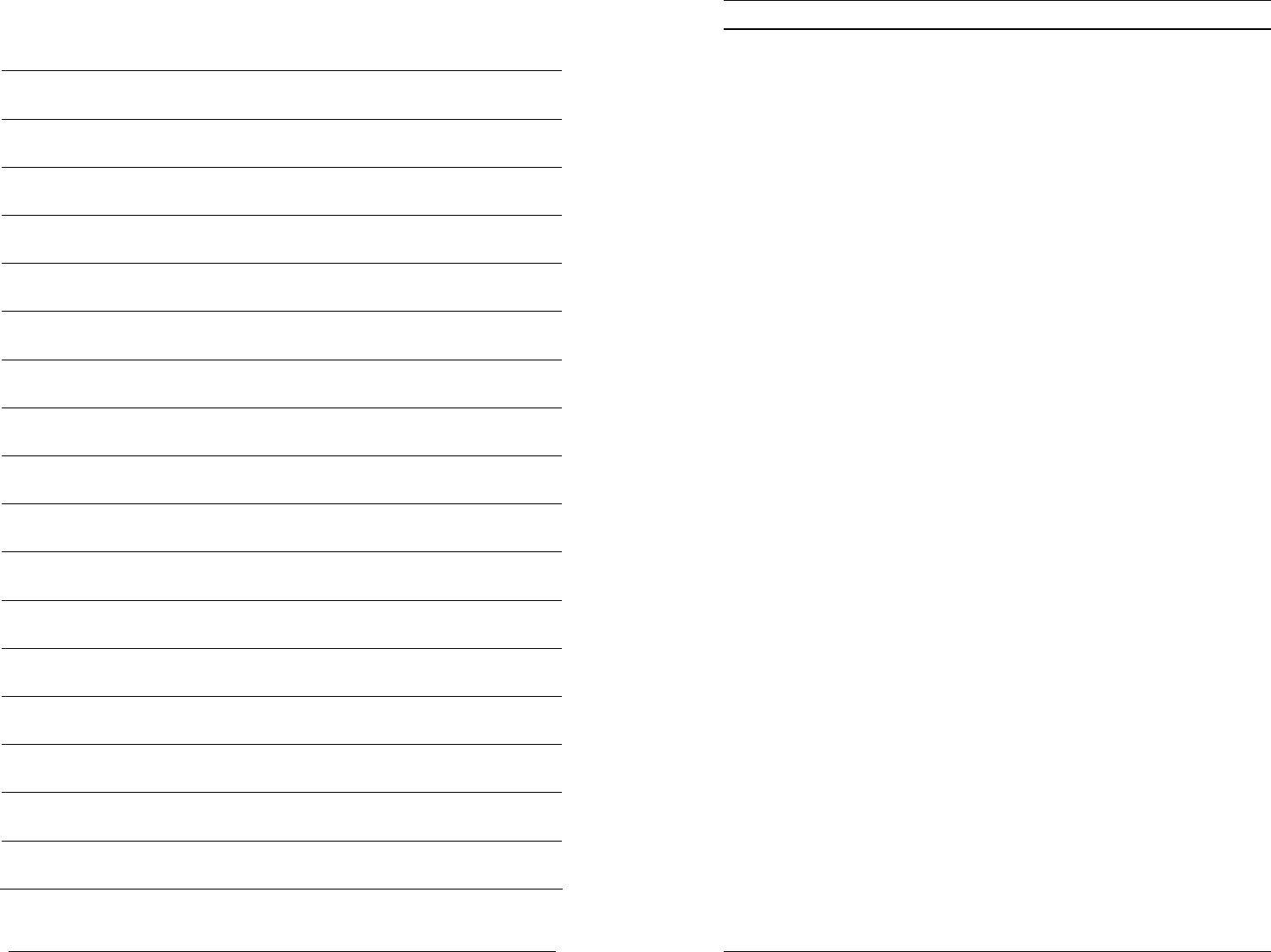
42 BK Radio
NOTES:
DPH Owner’s Manual 3
TABLE OF CONTENTS
Features..................................................................... Inside Front Cover
Introduction ............................................................................................ 4
FCC Requirements ................................................................................ 4
Safety Precautions................................................................................. 4
RF Energy Exposure Awareness And Control Information ................... 5
Radio Controls ....................................................................................... 8
Basic Operation ..................................................................................... 9
Channel Guard Operation.................................................................... 10
Mixed Mode Operation......................................................................... 12
Channel Groups................................................................................... 13
Programmable Top Switches/ Function Menu..................................... 15
Scan Operation .................................................................................... 16
Priority Scan......................................................................................... 19
Unit-To-Unit Call .................................................................................. 25
Emergency Call.................................................................................... 30
User Selected Channel Guard............................................................. 30
Other Operational Features ................................................................. 31
Alphanumeric Display .......................................................................... 35
Cloning Procedure ............................................................................... 37
Battery Installation And Removal......................................................... 40
Definitions And Acronyms.................................................................... 41
Service ....................................................................... Inside Back Cover
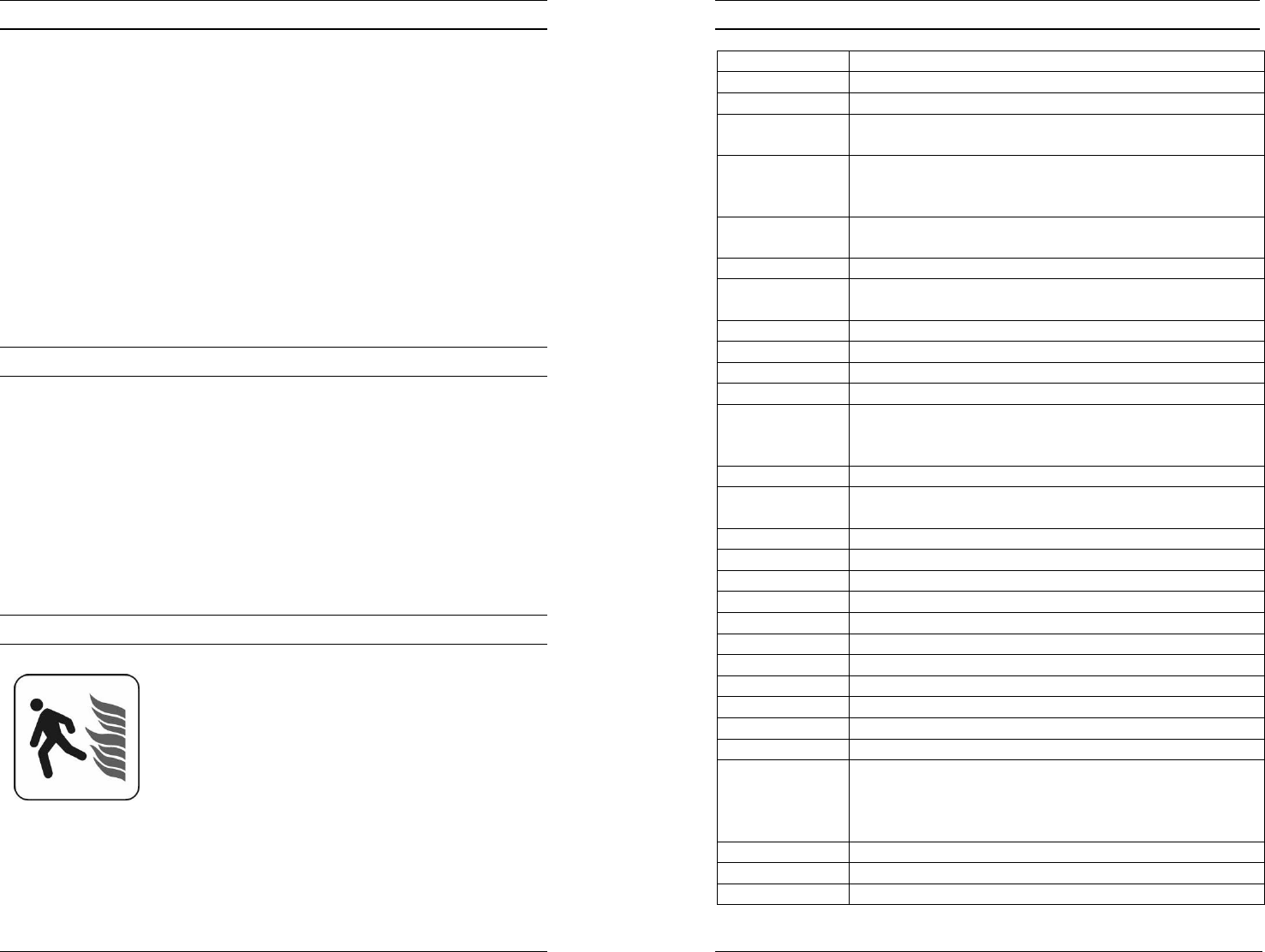
4 BK Radio
INTRODUCTION
CONGRATULATIONS, you now own a BK Radio DPH APCO Project
25 digital radio. To meet backwards compatibility as defined by the
APCO Project 25 standard, the DPH digital portable radio provides
users the ability to interoperate with narrow or wide band analog
channels as well as digital systems. Please take a moment to read the
information in this manual so you can get optimum performance from
your new radio.
FCC REQUIREMENTS
Your radio must be properly licensed by the Federal Communications
Commission prior to use. Your BK Radio dealer can assist you in
meeting these requirements. Your dealer will program each radio with
your authorized frequencies, signaling codes, etc., and will be there to
meet your communications needs as your system expands.
SAFETY PRECAUTIONS
• Do not operate the transmitter in close proximity
to blasting caps.
• Do not operate the radio in an explosive
atmosphere (petroleum fuels, solvents, dust,
etc.) unless your radio is an intrinsically safe
model designed for such use.
DPH Owner’s Manual 41
DEFINITIONS AND ACRONYMS
ANI Automatic Numeric Identification
CG Channel Guard
CLR Clear
Cloning The process of copying data from one radio, called
“master,” to other radios, called “slaves” or “clones.”
Channel
Guard
A sub-audible tone, a code (analog) or a Network
Access Code (digital) for selective listening and
receiving.
Detent The click/hesitation you feel as you turn a knob from
one position to another.
DTMF Dual Tone Multiple Frequency
DTMF Tones Tones that sound like those used by a standard
push-button telephone.
ENT Enter
FCN Function
GRP Group Label
ID Digital reception/transmission – ‘It’s Digital.”
Individual
Personality
The information programmed with a PC both a
global and by-channel basis that tells the radio
exactly how to operate.
LCD Liquid Crystal Display
Mixed Mode Allows Analog and Digital operation on the same
channel.
NAC Network Access Code for digital channel.
PR Priority Channel
PRG Program
PRI Priority
PTT Push To Talk
RTA Repeater Talk Around
RTX Channel Ready to Transmit Channel
RX Receive
SCN Scan
SQ Squelch
Squelch A control that eliminates background noise.
Talkback Scan When scanning, if a signal is present, the scan will
stop and you will hear the signal. If you then push
the PTT switch to talk back to the person, you are in
Talkback Scan Mode.
TGID Talk Group ID
Time-Out-Timer A feature that limits the duration of calls.
TX Transmit
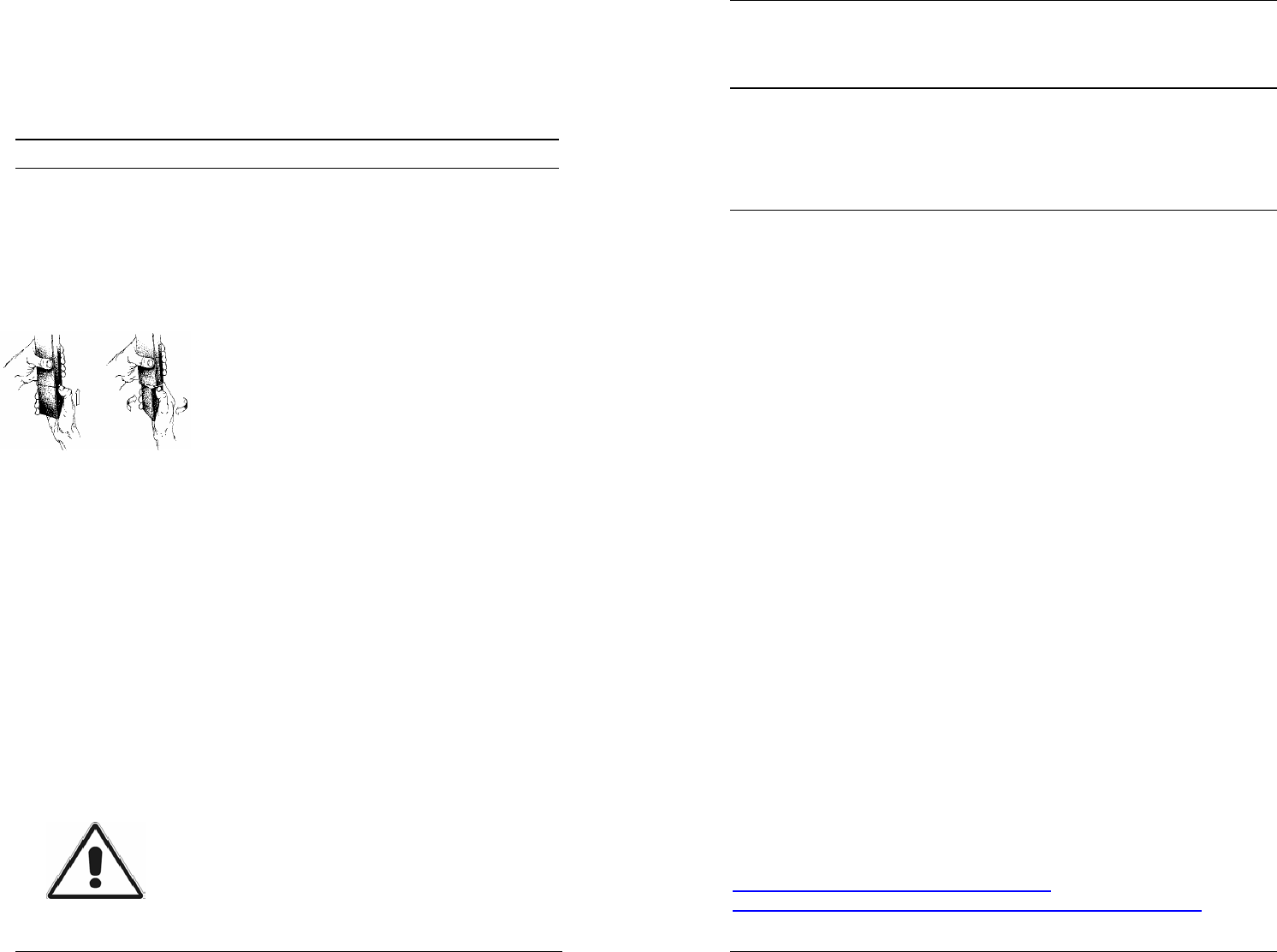
40 BK Radio
SCAN LIST CLONING
When a master radio downloads to a clone,
the Scan List is also transferred. See page 18
in this manual for selecting the Scan List.
BATTERY INSTALLATION AND REMOVAL
BK Radio battery packs are available in a variety of sizes and types for
special applications. Rechargeable battery packs can be charged
separately or while attached to a radio.
INSTALLING THE BATTERY
1. Locate the center hub on the radio base
and place it in the recess of the battery
pack.
2. Position the battery pack at the 30° offset,
seating the two metal studs in their recess.
3. Apply upward pressure to the pack while
twisting the pack to its original position.
The metal tab will click, locking the pack in
position.
REMOVING THE BATTERY
1. Turn the radio off.
2. Push up the metal tab on the side of the
case while twisting the battery pack
approximately 30°.
3. Remove battery pack from the radio.
NOTE: Periodically check the contacts
on the battery pack for dirt that
could prevent a good electrical
contact with the charging base.
WARNING: Explosion Hazard
Do not dispose a battery pack into a fire.
An explosion may occur.
DPH Owner’s Manual 5
RF ENERGY EXPOSURE AWARENESS AND
CONTROL INFORMATION, AND OPERATIONAL
INSTRUCTIONS FOR FCC OCCUPATIONAL USE
REQUIREMENTS
BEFORE USING YOUR PORTABLE 2-WAY RADIO,
READ THIS IMPORTANT RF ENERGY AWARENESS AND
CONTROL INFORMATION AND
OPERATIONAL INSTRUCTIONS TO ENSURE COMPLIANCE WITH
THE FCC’S RF EXPOSURE GUIDELINES.
NOTICE: This radio is intended for use in occupational/controlled
conditions, where users have full knowledge of their exposure
and can exercise control over their exposure to meet FCC limits.
This radio device is NOT authorized for general population,
consumer, or any other use.
This 2-way radio uses electromagnetic energy in the radio frequency
(RF) spectrum to provide communications between two or more users
over a distance. It uses radio frequency (RF) energy or radio waves to
send and receive calls. RF energy is one form of electromagnetic
energy; other forms include electric power, radar, sunlight and x-rays.
RF energy, however, should not be confused with these other forms of
electromagnetic energy, which when used improperly can cause
biological damage. Very high levels of x-rays, for example, can
damage tissues and genetic material. The energy levels associated
with radio waves from portable 2-way radios, when properly used, are
not great enough to cause biological damage.
Experts in science, engineering, medicine, health and industry work
with organizations to develop standards for exposure to RF energy.
These standards provide recommended levels of RF exposure for both
workers and the general public. These recommended RF exposure
levels include substantial margins of protection. All 2-way radios
marketed in North America are designed, manufactured and tested to
ensure they meet government established RF exposure levels. In
addition, manufacturers also recommend specific operating
instructions to users of 2-way radios.
These instructions are important because they inform users about RF
energy exposure and provide simple procedures on how to control it.
Please refer to the following WEBSITES for more information on what
RF energy exposure is and how to control your exposure to assure
compliance with established RF exposure limits.
http://www.fcc.gov/oet/rfsafety/rf-faqs.html
http://www.osha.gov/SLTC/radiofrequencyradiation/index.html
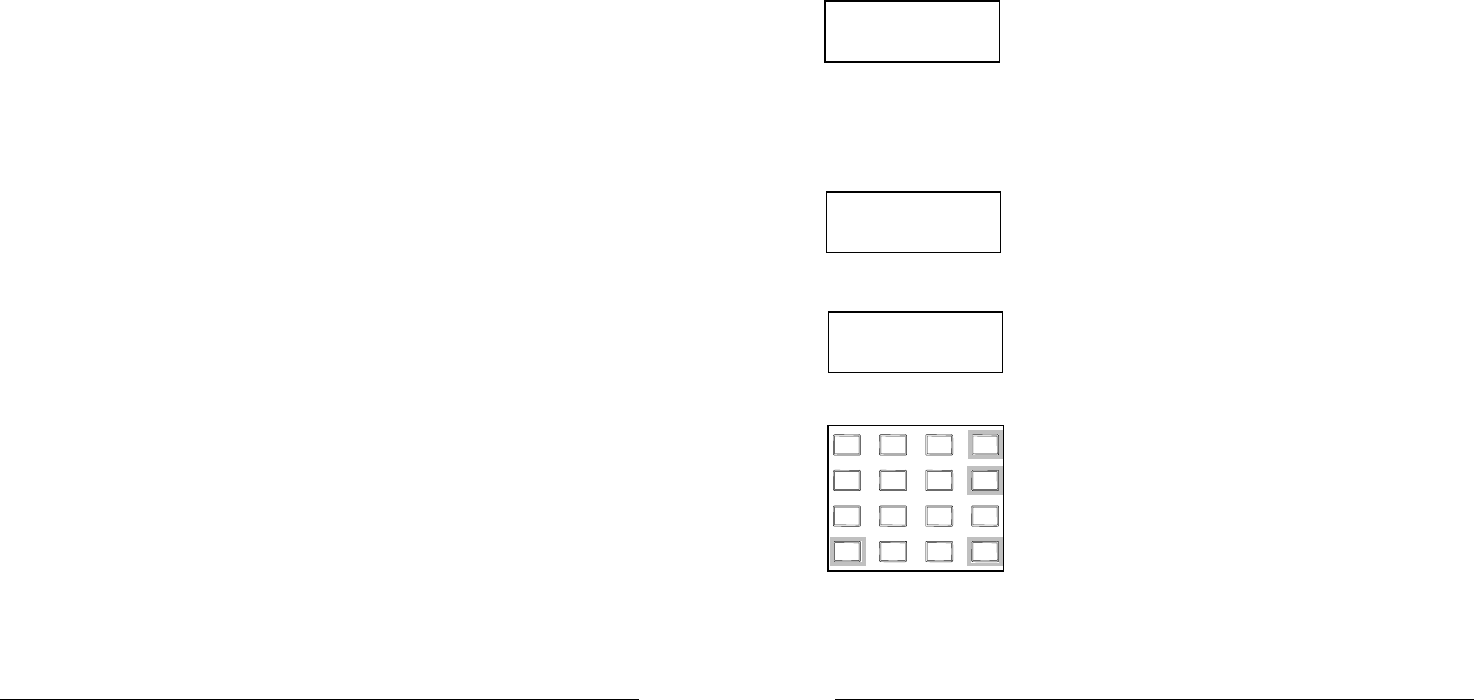
6 BK Radio
FEDERAL COMMUNICATIONS COMMISSION
REGULATIONS
The FCC rules require manufacturers to comply with the FCC RF
energy exposure limits for portable 2-way radios before they can be
marketed in the U.S. When 2-way radios are used as a consequence
of employment, the FCC requires users to be fully aware of and able to
control their exposure to meet occupational requirements. Exposure
awareness can be facilitated by the use of a product label directing
users to specific user awareness information. Your BK Radio 2-way
radio has a RF exposure product label. Also, your BK Radio owner’s
and service manuals include information and operating instructions
required to control your RF exposure and to satisfy compliance
requirements.
COMPLIANCE WITH RF EXPOSURE STANDARDS
Your BK Radio 2-way radio is designed and tested to comply with a
number of national and international standards and guidelines (listed
below) for human exposure to radio frequency electromagnetic energy.
This radio complies with the IEEE and ICNIRP exposure limits for
occupational/controlled RF exposure environment at operating duty
factors of up to 50% transmitting and is authorized by the FCC for
occupational use only. In terms of measuring RF energy for
compliance with the FCC exposure guidelines, your radio radiates
measurable RF energy only while it is transmitting (during talking), not
when it is receiving (listening) or in Standby Mode. Note: The approved
batteries supplied with this radio are rated for a 5-5-90 duty factor (5%
talk-5% listen - 90% standby), even though this radio complies with the
FCC occupational RF exposure limits and may operate at duty factors
of up to 50% talk.
Your BK Radio 2-way radio complies with the following RF energy
exposure standards and guidelines:
• United States Federal Communications Commission, Code of
Federal Regulations; 47 CFR §§ 1.1307, 1.1310, 2.1091 and
2.1093
• American National Standards Institute (ANSI) / Institute of
Electrical and Electronic Engineers (IEEE) C95. 1-1992
• Institute of Electrical and Electronic Engineers (IEEE) C95.1-
1999 Edition
INDUSTRY CANADA COMPLIANCE
This Class B digital apparatus complies with Canadian ICES-003.
Cet appareil numerique de la classe B est conforme à la norme NMB-
003 Canada.
DPH Owner’s Manual 39
SPECIAL CLONING INSTRUCTIONS
You can change Channel 0 values on the master radio, hold them in a
temporary memory, and download them to the clone without actually
entering them into the permanent memory of the master. This is
convenient if sequential identification numbers are used to identify a
series of portables in a radio system. Assuming that the frequencies,
Channel Guard values, and other CH 0 values are common for all
radios in the system, but that the radio identification number should be
unique to each radio, the following method can be used to clone
additional radios for the system:
1. Program the master with all frequencies,
Channel Guard values, and Channel 0
values that will be common to all radios.
2. Advance the display to show the ID
number of the master (for example 100).
3. Press [CLR]; press 1, 2, and 5. The ID
number 125 is now only in temporary
memory.
4. Press [*], connect the cloning cable to the
clone radio, and download by pressing
[FCN]. ID number 125 is now stored in the
permanent memory of the clone.
5. After downloading, press [CLR] on the
Master radio. Disconnect the clone. The
master radio display will show that 125 is
still being held in the temporary memory of
the master.
6. Press [PRI]. This will increment the ID
number one digit to 126.
NOTE: Any new number can be entered
at this point by pressing [CLR]
and using the keypad to enter the
new number.
7. Press [*]. Connect the cloning cable to
the next clone and download by pressing
[FCN].
Any number of radios can be coded with
different or sequential ID numbers using
this technique. The ID number in the
permanent memory of the master will
remain unchanged at 100.
PRG ID
1
2
5
PRG ID
12
5
PRG ID
126
1 2 3
4 5 6
7 8 9
0
*
#
CLR
FCN
PRI
ENT
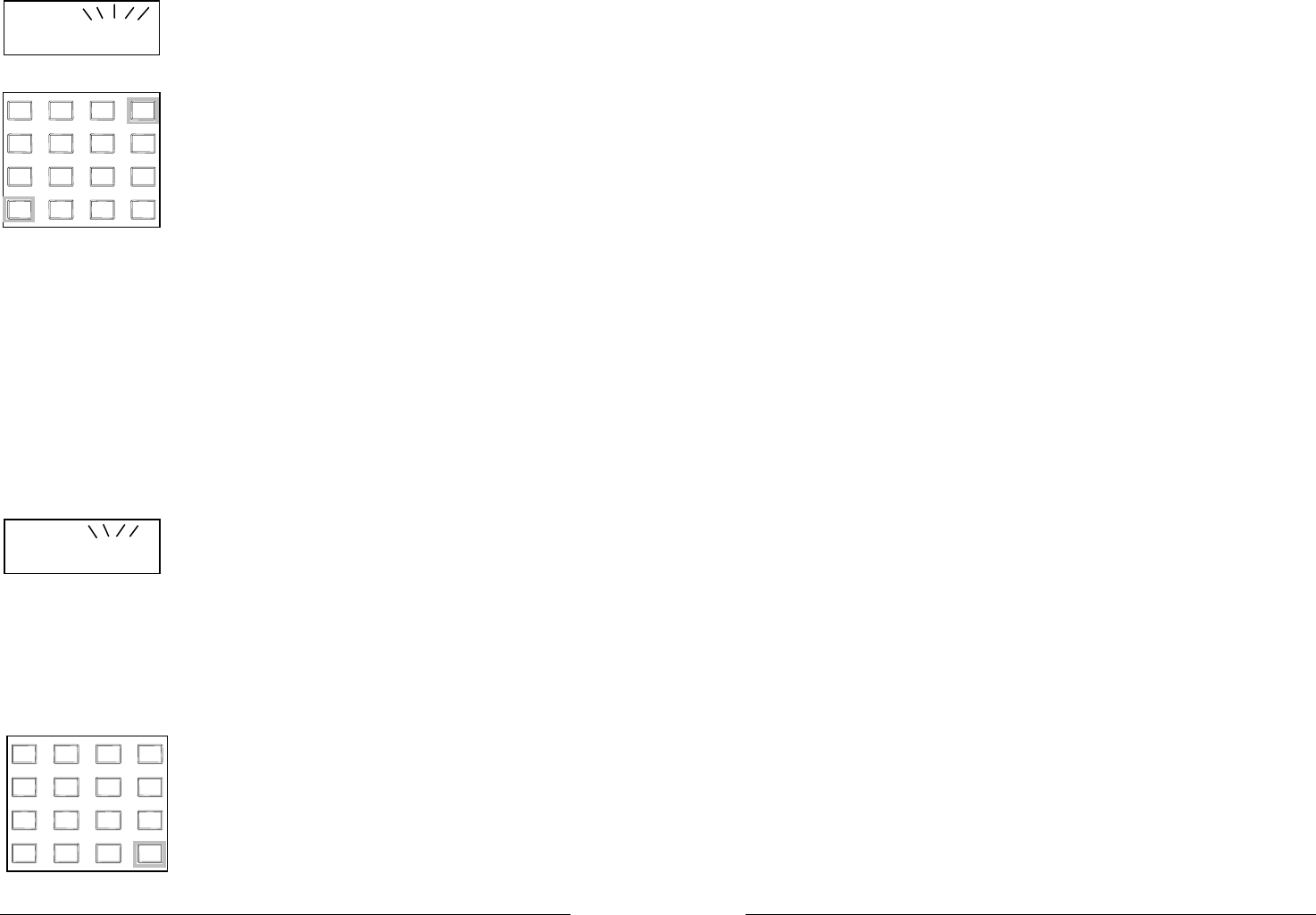
38 BK Radio
8. Turn on the clone and set it to the desired
channel group.
9. Press the [*] key on the master radio
keypad. The display will flash PROG
signifying that the radio is ready to
download its program to the clone.
10. Press the [FCN] key on the master radio
keypad. The program in the master will
then be downloaded to the clone.
11. If the download was successful, the
display on the master will resume flashing
PROG.
• To clone another channel group, turn
off both radios and go back to Step 3
on the previous page, changing the
channel group as required.
• If cloning is finished, turn off the clone
and disconnect the cloning cable.
Normal radio operation will occur
when you turn on the clone.
12. If the download was not successful, the
master will display FAIL and multiple
beeps will follow. Failure of downloading
can be due to:
• Improper connection
• Failure to turn on the clone
• Setting the clone in Programming
Mode
• Group ‘locked’ by PC Programming
NOTE: To stop the FAIL Mode, press
[CLR], turn off both radios, and
try again, starting with Step 1 on
the previous page.
PRG
FAI
L
PRG
PROG
1
2
3
4
5
6
7
8
9
0
*
#
CLR
FCN
PRI
ENT
1
2
3
4
5
6
7
8
9
0
*
#
CLR
FCN
PRI
ENT
DPH Owner’s Manual 7
RF EXPOSURE COMPLIANCE AND CONTROL GUIDELINES
AND OPERATING INSTRUCTIONS
To control your exposure and ensure compliance with the
occupational/controlled environment exposure limits always adhere to
the following procedures.
Guidelines:
• Do not remove the RF Exposure Label from the device.
• User awareness instructions must accompany device when
transferred to other users.
• Do not use this device if the operational requirements described
herein are not met.
Operating Instructions:
• Transmit no more than the rated duty factor of 50% of the time. To
transmit (talk), push the Push-To-Talk (PTT) button. To receive calls,
release the PTT button. Transmitting 50% of the time, or less, is
important because this radio generates measurable RF energy
exposure only when transmitting (in terms of measuring for standards
compliance).
• Hold the radio in a vertical position in front of face with the
microphone (and the other parts of the radio, including the antenna)
at least one inch (2.5 cm) away from the nose. Keeping the radio at
the proper distance is important because RF exposures decrease
with distance from the antenna. Antenna should be kept away from
eyes.
• When worn on the body, always place the radio in a BK Radio
approved clip, holder, holster, case, or body harness for this product.
Using approved body-worn accessories is important because the use
of BK Radio or other manufacturer’s non-approved accessories may
result in exposure levels which exceed the FCC’s
occupational/controlled environment RF exposure limits.
• If you are not using a body-worn accessory and are not using the
radio in the intended use position in front of the face, then ensure the
antenna and the radio are kept at least one inch (2.5 cm) from the
body when transmitting. Keeping the radio at the proper distance is
important because RF exposures decrease with increasing distance
from the antenna.
• Use only BK Radio approved supplied or replacement antennas,
batteries, and accessories. Use of non-BK Radio approved
antennas, batteries, and accessories may exceed the FCC RF
exposure guidelines.
• For a list of BK Radio approved accessories visit the following
website : http://www.relm.com.
CONTACT INFORMATION
For additional information on exposure requirements or other
information, visit website http://www.relm.com.
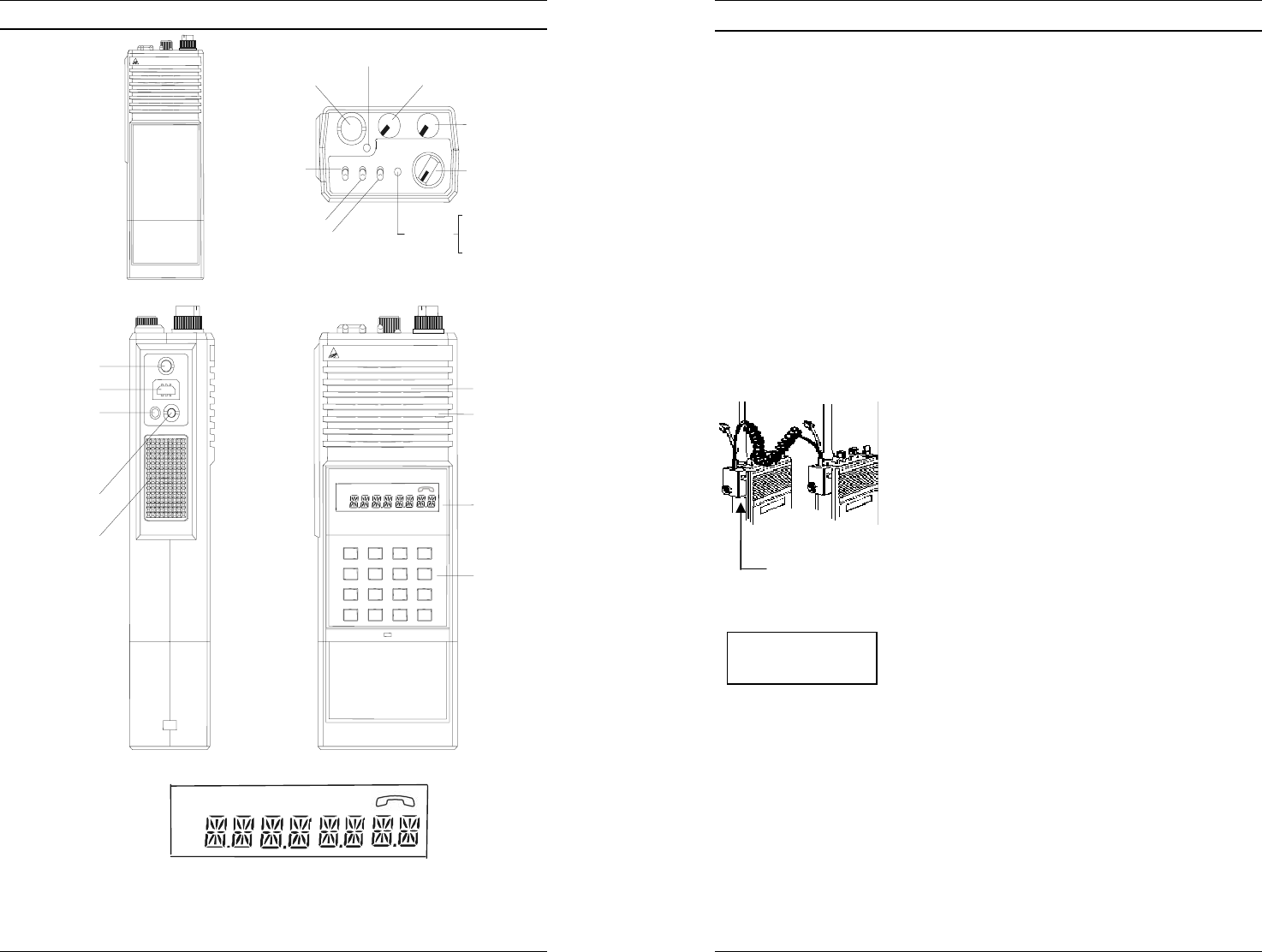
8 BK Radio
RADIO CONTROLS
BK RADIO
1
2 3
4
5 6
7
8 9
0
*
#
CLR
FCN
PRI
ENT
PRIORITY
BUSY CHANNEL
LOW BATTERY
INDICATOR
TRANSMIT
INDICATOR
ANTENNA
HI/LO
TRANSMIT
POWER
SCAN
PRIORITY
ANTENNA
ACCESSORY
MOUNT
EARPHONE
PTT
(PUSH TO TALK)
SPEAKER
MICROPHONE
LCD DISPLAY
CHANNEL
SELECT
ON/OFF
VOLUME
SQUELCH
CODE GUARD
G
R
P
PRG
TX
RX SCN ID CG
DPH RADIO WITH
KEYBOARD/DISPLAY
COVERED OR
NOT INSTALLED
(REDUCED VIEW)
BK RADIO
CG- OFF-
SQ VOL
161
2
3
4
5
67891011
12
13
14
15
A
B
C
KEYBOARD
DPH RADIO WITH
KEYPAD/DISPLAY
COVERED
(REDUCED VIEW)
R
X
SCN
TX
PRG ID CG
P
R
G
.
.
.
R
X
SCN
TX
PRG ID CG
P
R
G
.
.
.
ALPHANUMERIC DISPLAY
SQUELCH
CHANNEL GUARD
TX
DIGITAL
DPH Owner’s Manual 37
Master Clone
Master
Switch
CLONING PROCEDURE
Any “master” radio (a DPH with the desired radio frequencies and
settings) is capable of transferring its program to another DPH or
“slave” radio. The radio receiving the program is also referred to as the
“clone.” The LAA0700 cloning cable will be required in the following
procedure. Contact your BK Radio dealer for information on cloning
between DPH radios and other BK Radio products.
NOTE: some groups may be “locked” by PC programming to prevent
them from being overwritten. Only “unlocked” groups will
accept incoming clones.
1. Make sure the battery packs for both
radios are charged.
2. Attach the master switch end of the
cloning cable to the side connector of the
master radio.
NOTE: One plug of the cloning cable
has a push-button master
switch. This plug must be
attached to the master radio.
3. Turn on the master radio.
4. Select the group to be cloned from the
master radio.
5. Put the master radio in Programming
Mode by pressing and holding the master
switch then pressing and holding the
[FCN] key until the display shows ‘- - - ID.’
Enter the password of the selected group.
The display shows ‘PRG CH 00.’
6. Review the values programmed in the
radio by pressing the [FCN] or [ENT] key
at each CHXX prompt. Any required
changes must be made now.
7. Connect the other plug of the cable to the
side connector of the radio you want to
clone.
PRG
C
H
0
0
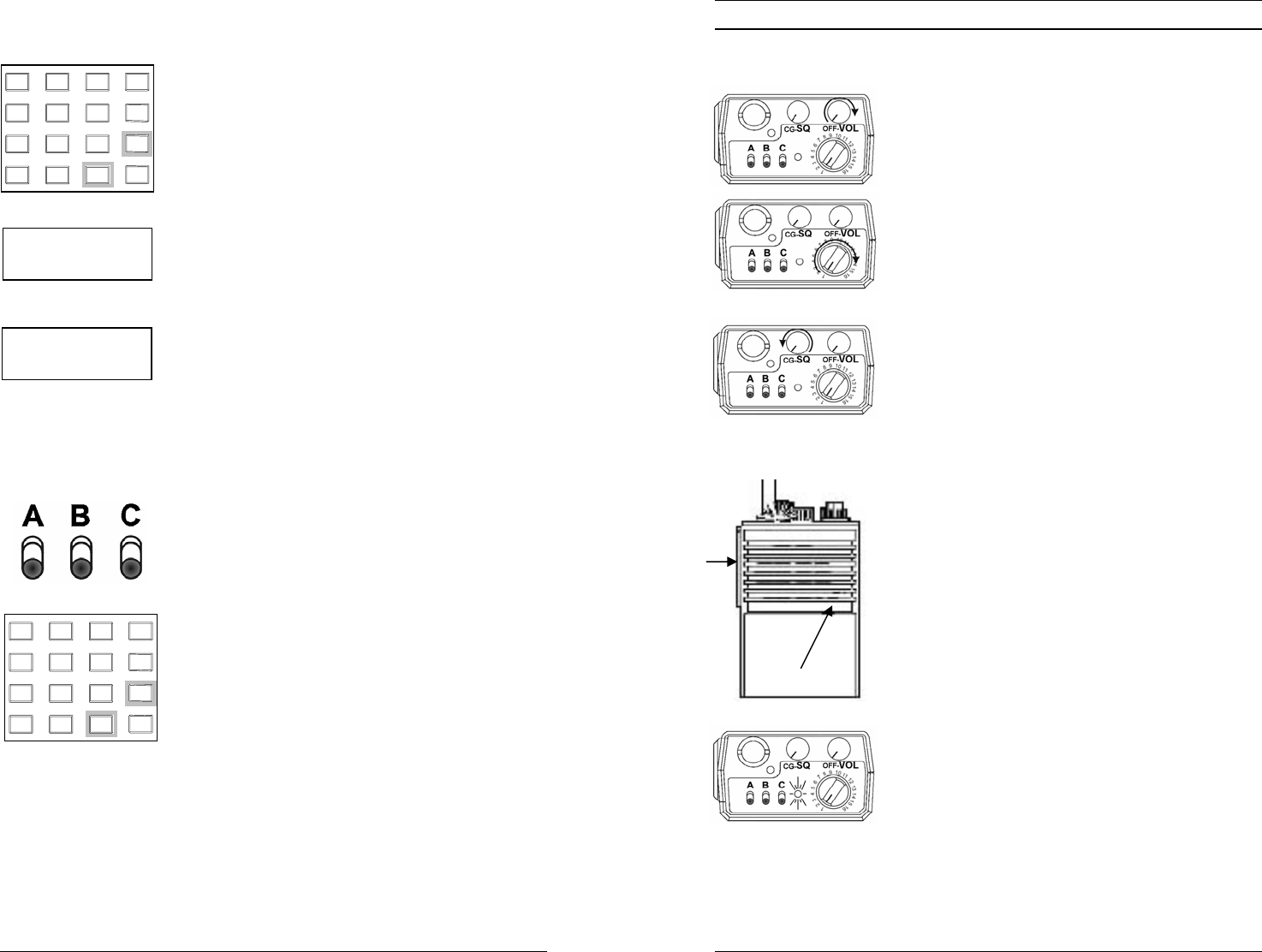
36 BK Radio
CHANNEL LABELS
You can program the radio with a label for
each of the 25 channel groups and a label for
each of the 16 channels within each group.
To display the channel number associated
with a channel label:
1. Press the [#] key to display the group
number.
2. Press the [#] key again to display the
channel number.
3. Press and hold the [#] key to display the
channel label.
4. Press [ENT].
Each label can include up to eight characters,
with decimal points available between
characters. Characters can include A–Z, 0–9,
-, *, $, /, +, %, \, |, _, <, >, h, or a blank space.
GROUP LABELS
The display can show group labels in addition
to group numbers.
To display a group label, turn scanning
functions off, then:
1. Press the [#] key on the keypad to display
the group number.
2. Press and hold the [#] key to display the
group label.
3. Press the [ENT] key or wait for about
5 seconds to revert to normal radio
operation.
F
I
R
E
NE
T
Channel Label
C
H
1
2
Channel Number
1 2 3
4 5 6
7 8 9
0
* # CLR
FCN
PRI
ENT
1 2 3
4 5 6
7 8 9
0
* # CLR
FCN
PRI
ENT
DPH Owner’s Manual 9
BASIC OPERATION
RECEIVE 1. Turn power on by turning the Volume knob
clockwise. A beep sounds, indicating the
radio is operational. The LCD display, if
installed, shows the current channel.
2. Select a channel by turning the 16-position
Channel Selector knob.
3. Adjust squelch and volume by turning the
Squelch knob clockwise until you hear
noise. Set the volume to a comfortable level.
Then turn the Squelch knob
counterclockwise until the noise stops. This
is called the Threshold Squelch setting.
Turning the Squelch knob fully counterclockwise
past the detent places the receiver in Channel
Guard. A message will be heard only when the
proper Channel Guard value is received.
TRANSMIT 1. Press the PTT (Push-To-Talk) switch. When
the transmitter is on, the red Transmit
Indicator glows and TX appears in the
display.
2. Talk in a normal voice with the microphone
one to two inches from your mouth.
3. Release the PTT switch to stop transmitting.
If the Transmit Indicator does not glow when you
press the PTT switch, the battery pack may
need to be charged. If so, the display will
indicate LOBATT, and the yellow Low-Battery
Indicator will flash. If the Transmit Indicator does
not glow and a tone sounds, you are on a
receive-only channel or the channel is busy (if
Busy Channel lockout is enabled). Select an
authorized transmit channel.
If the length of your message exceeds the
preset Time-Out-Timer setting, the transmitter
automatically shuts off and a tone sounds. To
continue transmission, release the PTT switch,
and then press it again and continue talking.
Microphone
PTT
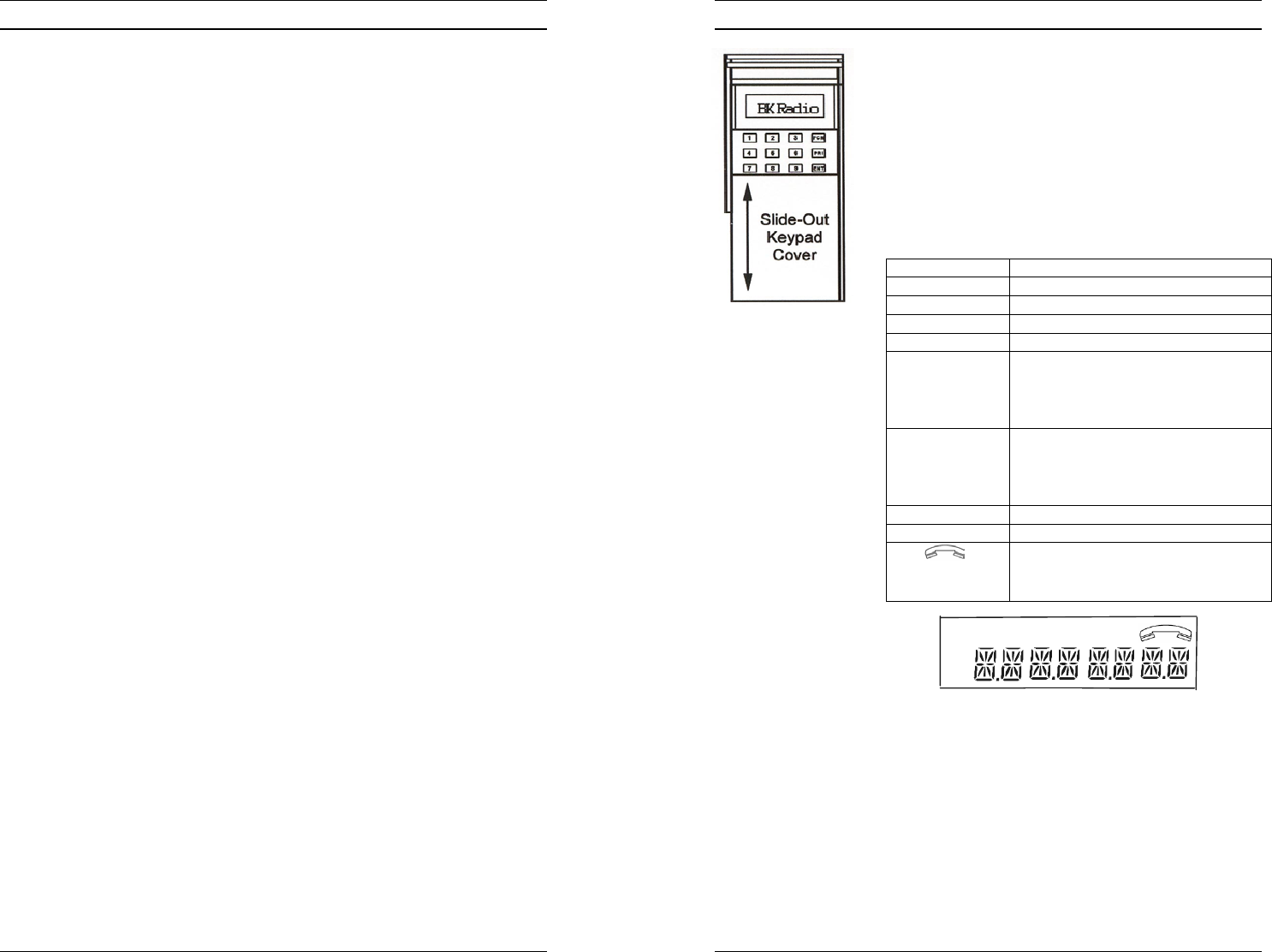
10 BK Radio
CHANNEL GUARD OPERATION
ANALOG SQUELCH CONTROL
Sub-audible signaling (CTCSS/CDCSS) is used
to allow a group of radios to be selectively called
in a system. Programming the receive guard
equal to zero allows for Carrier Squelch
operation, where the radio will unmute whenever
a carrier is detected.
APCO PROJECT 25 SQUELCH CONTROL
Network Access Codes (NACs) provide the
digital equivalent of analog sub-audible signaling
(CTCSS/CDCSS) allowing a group of radios to
be selectively called within a system.
Users in the same area (using the same NAC)
can be further divided into Talk Groups, with
each group having its own Talk Group ID (TGID).
Group Calls are made by designating both the
users’ NAC and TGID.
Each radio also has an individual P25 unit ID. A
Unit-to-Unit call contains the addressee’s NAC,
and uses the addressee’s P25 unit ID instead of
the TGID.
When operating in Digital Mode, each channel
can be programmed to use either Normal
squelch or Selective squelch.
1. Normal squelch is used to mimic analog
operation. Signals are only qualified with the
programmed NAC. TGIDs and P25 Unit IDs
are ignored. Each digital channel is
programmed with a receive NAC and a
transmit NAC. When an incoming signal’s
NAC matches the channel’s programmed
receive NAC, the radio unmutes. The default
NAC is 659 ($293 hex). The digital
equivalent of carrier squelch is achieved by
programming the receive NAC = 3966($F7E
hex) the radio will unmute when a digital
signal with any NAC is detected. The 3966
($F7E hex) NAC is reserved for receivers
and is not allowed as a transmit NAC.
DPH Owner’s Manual 35
P
R
G
.
.
.
R
X
SCN ID CG
ALPHANUMERIC DISPLAY
TX
PRG
ALPHANUMERIC DISPLAY
DPH radios have a slide-out keypad/display
cover. To remove or install the cover, turn off
the radio and remove the battery (see Battery
Installation and Removal, page 40).
The Alphanumeric Display can be
programmed to operate in Numeric Mode,
displaying channel numbers instead of labels.
Display annunciators indicate the following
information:
Alphanumeric Indication
PR -Priority Channel
PRG -Programming Mode (includes PR)
TX -Transmit
RX -Receive
SCN -Scan List Channel
-Flashing SCN indicates scanning
in progress and RX SCN indicates
receiving on a scanned channel.
ID -Digital reception/transmission –
‘It’s Digital’
-Programming Mode – Automatic
Numeric Identification (ANI)
CG -User Channel Guard Active
GRP -Group Label
-Individual Call
-Flashing phone icon indicates
missed call.
DPH Series portable radios with alphanumeric
displays can be programmed with the
following features:
DISPLAY BACKLIGHTING
The DPH radios can be programmed by your
dealer to backlight the display when a signal is
received or when a key is pressed. The time
duration of the backlighting can also be
programmed.
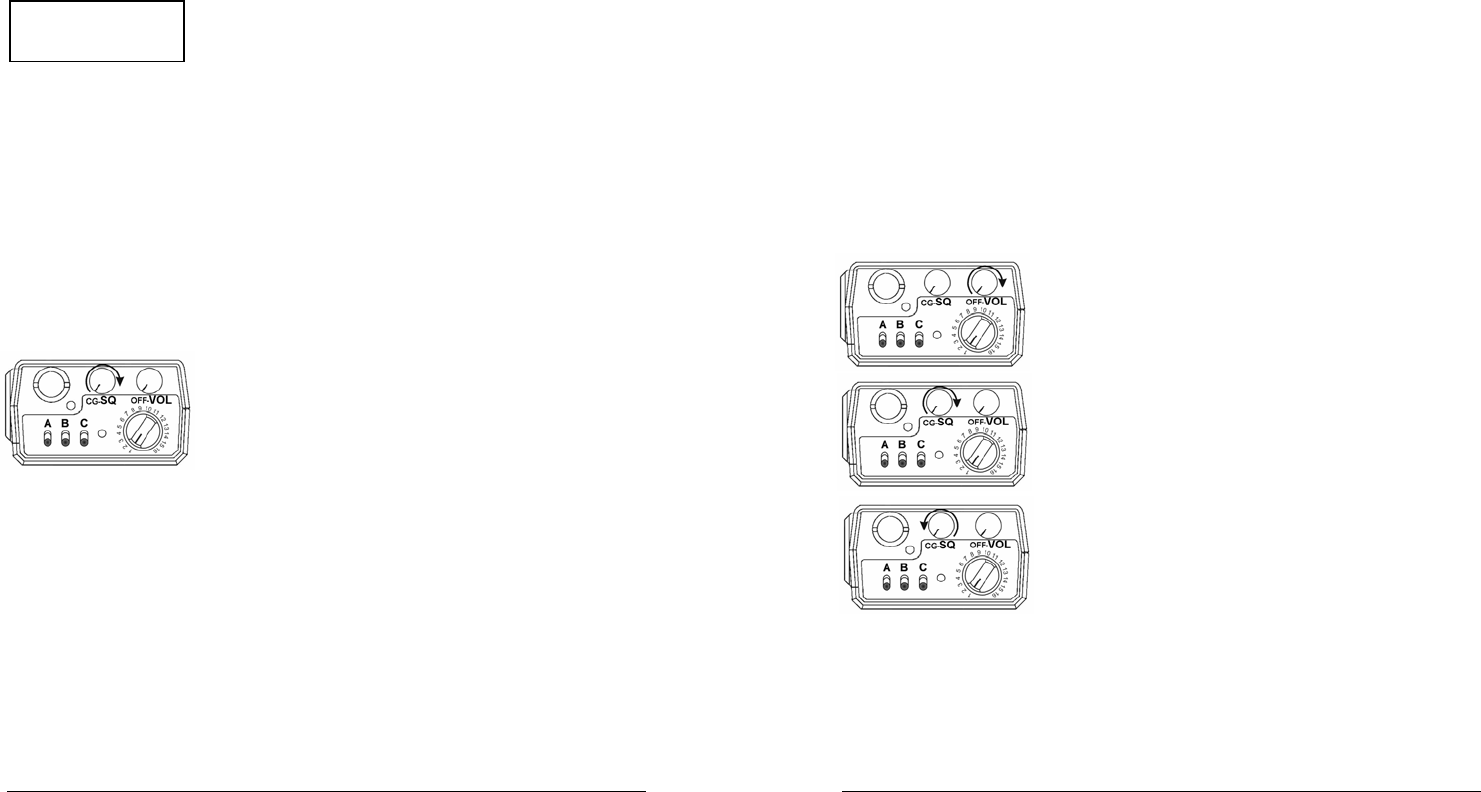
34 BK Radio
BUSY CHANNEL LOCKOUT
The Busy Channel Lockout feature applies
only to those channels programmed with a
receive Channel Guard value. When carrier
activity is detected on the channel selected,
the radio checks the receive Channel Guard
value. If the proper Channel Guard value is
present, the radio can transmit on that
channel, even if the Squelch knob is in the
Channel Guard position.
If the radio detects an incorrect value or carrier
activity only, the transmitter is disabled. If an
attempt is made to transmit, an alert tone will
be generated and the display will show the
word BUSY until the channel becomes
available or the PTT switch is released,
whether the Squelch knob is in or out of the
Channel Guard detent.
Channels not programmed with a receive
Channel Guard value can be used to transmit
regardless of carrier activity.
BUSY CHANNEL LOCKOUT OVERRIDE
This mode operates in the same manner as
Busy Channel Lockout except that the user
can override and transmit by turning the
Squelch knob off the Channel Guard detent.
The transmitter is locked out only if the
Squelch knob is set to the Channel Guard
detent.
BUS
Y
DPH Owner’s Manual 11
2. Selective squelch is used for processing
‘Group Calls’ and ‘Unit-to-Unit Calls’. TGIDs
are assigned on a per-channel basis. Users
can be separated into Talk Groups with each
group having its own TGID. Then, on
channels programmed for Selective squelch,
the incoming signal’s NAC and TGID must
match the channels programmed receive
NAC and TGID for the radio to unmute. The
default TGID is 1. The TGID value 65535
($FFFF hex) is used to effect an “All Call”. If
the radio receives a signal with a matching
NAC and the TGID = 65535 ($FFFF hex), it
will unmute. Also, if the radio’s programmed
TGID is 65535 ($FFFF hex), it will open on
any signal with a matching NAC, ignoring the
incoming TGID. A TGID = 0 means “no
one”. If the radio is programmed with the
TGID = 0, it will accept incoming group calls
containing the “All Call” TGID, and correctly
addressed Unit-to-Unit calls.
CHANNEL GUARD RECEIVE
1. Turn power on by turning the Volume knob
clockwise.
2. Select a Channel Guard channel by turning
the Channel Selector knob.
3. Adjust volume by turning the Squelch knob
clockwise until a noise is heard. Set the
volume to a comfortable level.
4. Set Channel Guard Mode by turning the
Squelch knob off (counterclockwise) into the
Channel Guard position. A message will be
heard only when the proper Channel Guard
value is received.
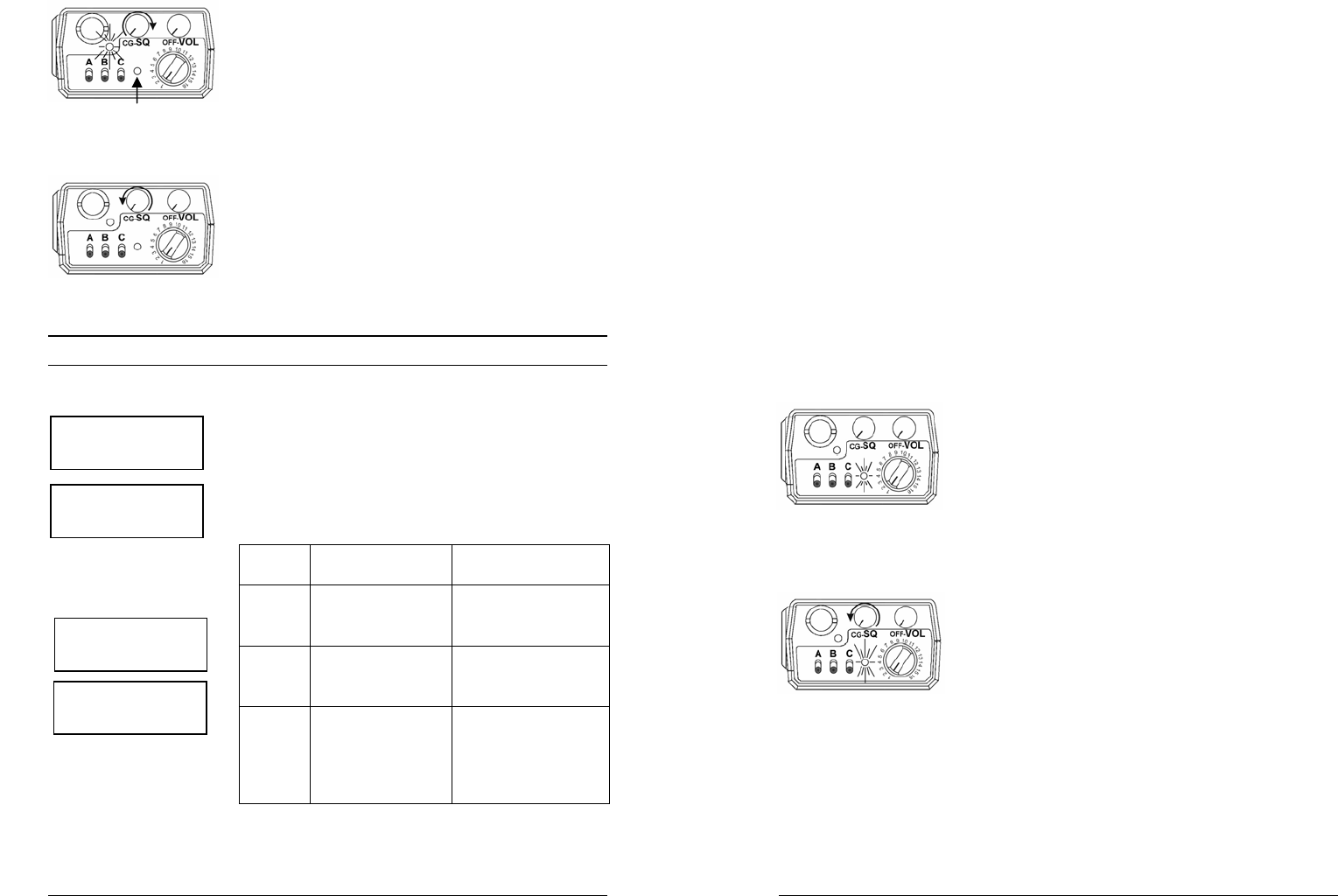
12 BK Radio
CHANNEL GUARD TRANSMIT
1. Turn the Squelch knob on (clockwise) and
monitor the Channel Guard channel before
transmitting, or, if Busy Channel operation is
enabled, check the yellow LED.
NOTE: Do not transmit if the channel is
busy.
2. Press the PTT switch. When the transmitter
is on, the red Transmit Indicator glows and
TX appears in the display.
3. If monitoring the channel, reset the squelch
knob to the Channel Guard position to
receive only the messages with the proper
Channel Guard value. During extended
transmissions, the squelch can be left open
until the exchange has ended.
MIXED MODE OPERATION
The receiver and transmitter are capable of
operating in analog wide-band (25 kHz
channel spacing), analog narrow-band (12.5
kHz channel spacing) and APCO Project 25
Digital Mode.
Each channel’s Receive and Transmit Mode
can be set independently as follows:
Mode RX TX
Analog Receive qualified
analog signals
only
Transmit analog
signals only
Digital Receive qualified
digital signals
only
Transmit digital
signals only
Mixed Automatically
receive qualified
analog or digital
signals
Transmit analog or
digital signal,
depending on the
status of ‘TX
Digital’ soft switch.
Digital receptions and transmissions will be
indicated by illuminating the ‘ID’ annunciator in
addition to the ‘RX’ or ‘TX’ annunciator.
Analog
Operation
RX
C
H
1
2
TX
C
H
1
2
Digital
Operation
RX ID
C
H
1
2
TX ID
C
H
1
2
Busy Channel
Indicato
r
DPH Owner’s Manual 33
TIME-OUT-TIMER
The transmit Time-Out-Timer limits the
duration of calls and guards against
accidentally locking on the transmitter and
tying up the radio system. Your dealer can
program the duration of the Time-Out-Timer
(15–225 seconds, or disabled).
BUSY CHANNEL
If the radio has been programmed for Busy
Channel operation, it will operate in one of the
following three Modes:
• Busy Channel Indication
• Busy Channel Lockout
• Busy Channel Lockout Override
BUSY CHANNEL INDICATION
The yellow Busy Channel Indicator glows if
there is carrier activity on the selected
channel. If the selected channel is a Channel
Guard channel and the proper Channel Guard
value is not detected, the Busy Channel
Indicator remains on for the duration of the
carrier activity and no message is heard.
During Scan and Priority Scan operation, the
Busy Channel Indicator glows when activity is
detected on any channel on the Scan List.
When scanning or priority scanning Channel
Guard channels with the Squelch knob in the
Channel Guard position and activity has been
detected, the Busy Channel Indicator glows
for the time period necessary to determine if
the proper Channel Guard value has been
received. This will cause the Busy Channel
Indicator to flash at various rates.
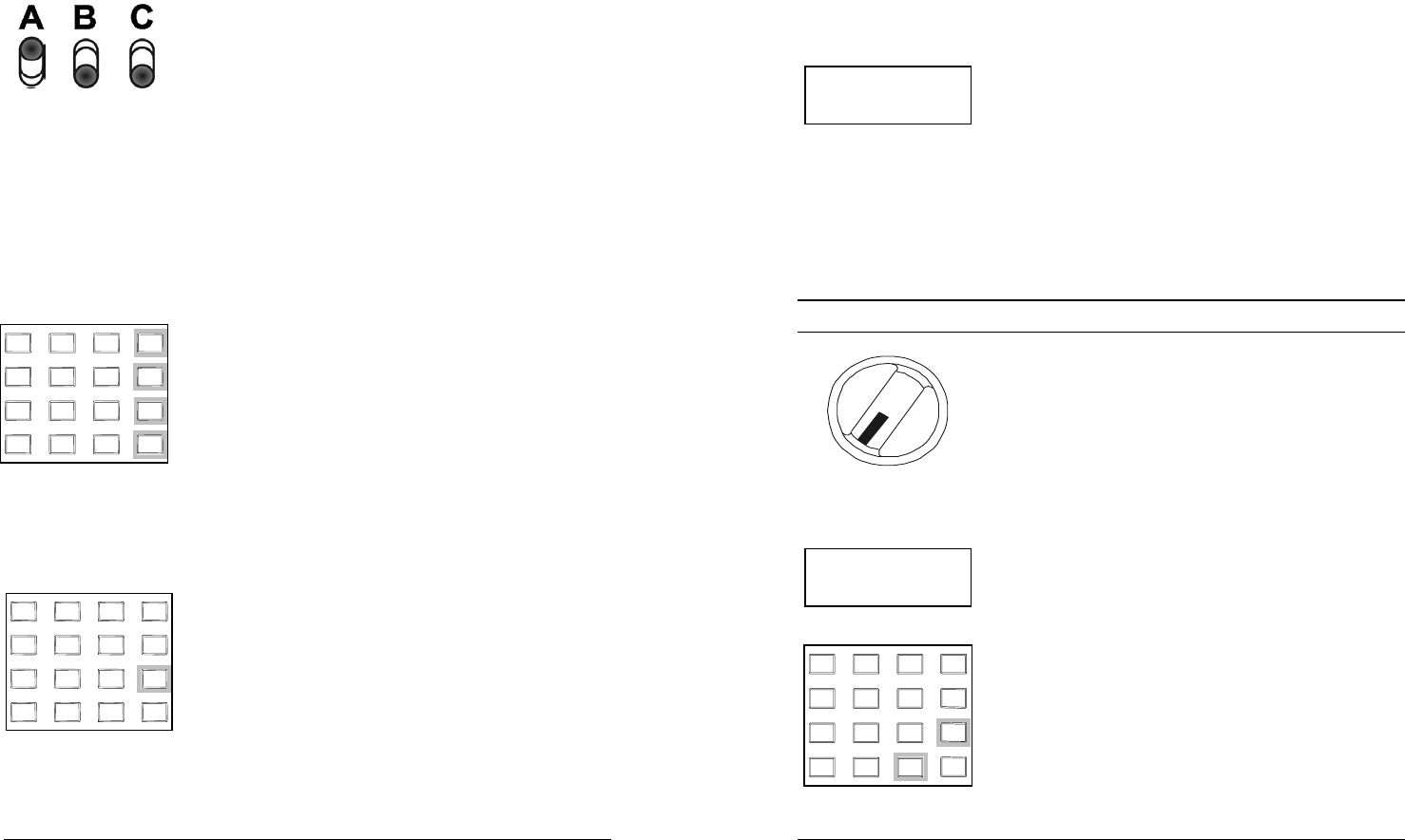
32 BK Radio
are received, you can ask your dealer to
increase the scan delay time (0–7.5 seconds).
This timer is also used to allow for Talkback
Scan, Mixed Mode Talkback, and Unit-To-Unit
Callback.
HI/LO POWER
Each channel in the radio can be individually
programmed to always transmit in Low-Power
Mode, regardless of the position of the radio's
top switch (or keypad [FCN] menu setting). If
the programming for the channel allows high-
power transmissions, the power level can be
selected with a top switch or the keypad
menu.
DTMF ENCODING (Analog Mode Only)
Keypad-equipped radios can be programmed
to enable DTMF (Dual Tone Multiple
Frequency) encoding. To send DTMF tones
(similar to the tones used by a standard push-
button telephone):
1. Press and hold the PTT switch.
2. Press any of the keys on the keypad.
You will hear a sidetone.
The FCN, PRI, ENT, and CLR keys respond
as DTMF tones A, B, C, and D, respectively.
ANI ENCODING (Analog Mode Only)
ANI encoding (Automatic Numeric
Identification), if enabled, transmits a
sequence of DTMF tones each time you press
the PTT switch. You will hear a sidetone. Your
dealer can program the ANI number to be
sent.
If DTMF and ANI are both enabled, the ANI
tone sequence is transmitted only after the
[ENT] key is pressed while the PTT switch is
activated. You will hear a sidetone.
1 2 3
4 5 6
7 8 9
0
* # CLR
FCN
PRI
ENT
1 2
3
4
5
6
7
8
9
0
*
#
CLR
FCN
PRI
ENT
DPH Owner’s Manual 13
MIXED MODE TALKBACK
If Mixed Mode Talkback is enabled,
transmissions initiated while hold time remains
will be in the same mode as the received
signal, if the signal was received on the Ready
to Transmit (RTX) channel. Depending on
programming, the RTX channel can be the
main channel, a held scan or priority channel if
Talkback Scan is enabled, or the Priority 1
channel if TX on PR1 is enabled. TX Mode on
the RTX channel must be set to MIXED.
While hold time after a reception remains,
transmissions will be in the same mode as the
received signal, regardless of the status of the
‘TX Digital’ soft switch. As in Talkback Scan,
the RTX channel and receive annunciators will
be displayed for the duration of the timer.
The talkback timer can be cleared by making
the held channel invalid. For instance, if a
scan channel is being held, turn scan off.
CHANNEL GROUPS
Radios are separated into groups of 16
channels each. Each group of 16 channels
can be programmed to have an "individual
personality" with its own set of operational
features.
SELECT A GROUP/CHANNEL
The Group/Channel Selector knob can be
programmed by your dealer as a Channel
Selector, a Group Selector, or a Custom
Group/Channel Selector.
CHANNEL SELECTOR. Knob positions
1–16 select channels in the group selected by
the keypad:
1. Press the [#] key on the keypad to display
the current group number.
RX
C
H
1
2
Press PTT
During Hold Time
(while the ‘RX’
annunciator is lit)
GR
P
0
1
Group Number
161
2
3
4
5
678910
11
12
13
14
15
1 2 3
4 5 6
7 8 9
0
* # CLR
FCN
PRI
ENT
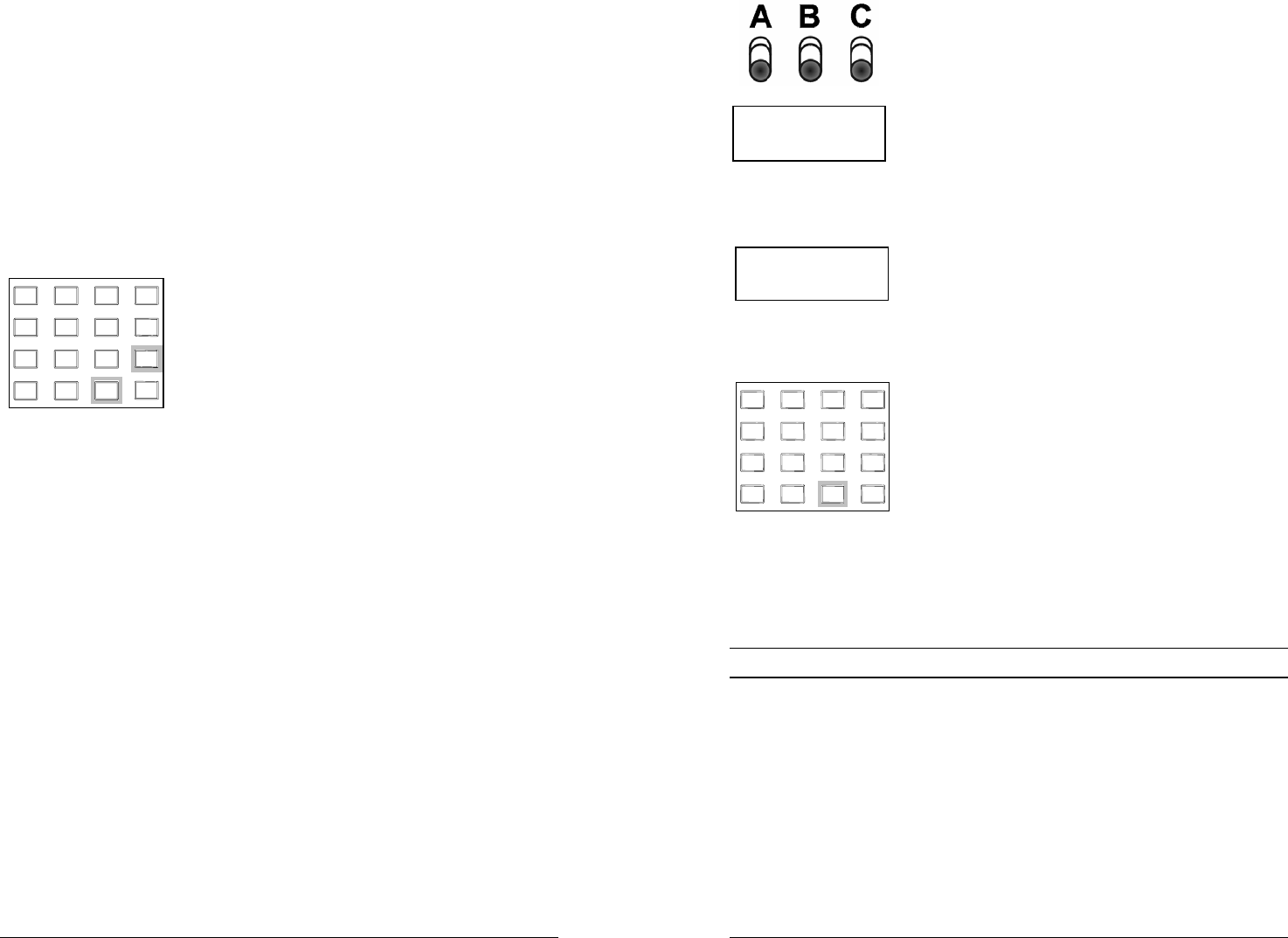
14 BK Radio
2. Press a number key for the new group
number. Only valid group entries will be
accepted.
When changing groups, invalid entries will
not be accepted, and the radio remains in
the previously selected group.
3. Press the [ENT] key or wait 5 seconds.
The radio returns to normal operation for
the new group, and the selected channel
is displayed. All selected scanning and
priority functions affect only the channels
in the group you are operating in.
GROUP SELECTOR. Knob positions
1–16 select groups 1–16:
1. Press [#] twice to select a channel.
2. Press a number key for the new channel
number.
3. Press the [ENT] key or wait 5 seconds.
The radio returns to normal operation for
the new channel, and the selected
channel is displayed.
CUSTOM SELECTOR. Your dealer will
provide you with the pre-programmed
Group/Channel combinations for your radio.
If a knob position is programmed to allow
selection of the group and/or channel with the
keypad:
1. Press [#].
2. Press the number of the group you want
to change to.
3. Press [#] again.
4. Press the number of the channel you want
to change to.
5. Press the [ENT] key or wait 5 seconds.
The radio returns to normal operation for
the new channel, and the selected
channel is displayed.
1 2 3
4 5 6
7 8 9
0
* # CLR
FCN
PRI
ENT
DPH Owner’s Manual 31
CG
LABE
L
5
Use Channel 9
Channel Guard Values
For Channel 5
For example, to use the Channel Guard
values of Channel 9 with the frequencies of
Channel 5:
1. Slide Switches B and C down.
2. Turn the channel selector knob to Channel
5.
3. Press the [9] key on the keypad. The
display shows CG.
The radio will now operate on the
frequencies of Channel 5 with Channel 9
Channel Guard values. The display shows
the Channel Guard channel (9), and then
the selected channel (5).
4. Press the [#] key to display the Channel
Guard channel briefly. The display shows
the group number, followed by the
Channel Guard channel, and then the
selected channel.
5. Press the [0] key to reset all values to the
original programming, or press different
number keys (1–16) to select a different
set of Channel Guard values.
NOTE: During Scan or Priority Scan, the
receiver does not use the user-
selected Channel Guard values.
However, user-selected Channel
Guard values are used by the
transmitter in Scan Mode.
OTHER OPERATIONAL FEATURES
The BK Radio D Series is based on a microprocessor core that allows
extra features and operational characteristics to be programmed into
the radio. Your dealer can help define the best operational settings for
your system and program them into the radio.
SCAN DELAY
Scan delay lets the radio receive a response
to a transmission before scanning the other
channels for activity. If you find that your
scanner is restarting before message replies
CG
L
A
BE
L
9
Copy Channel Guard
Values from
Channel 9
1
2
3
4
5
6
7
8
9
0
*
# CLR
FCN
PRI
ENT
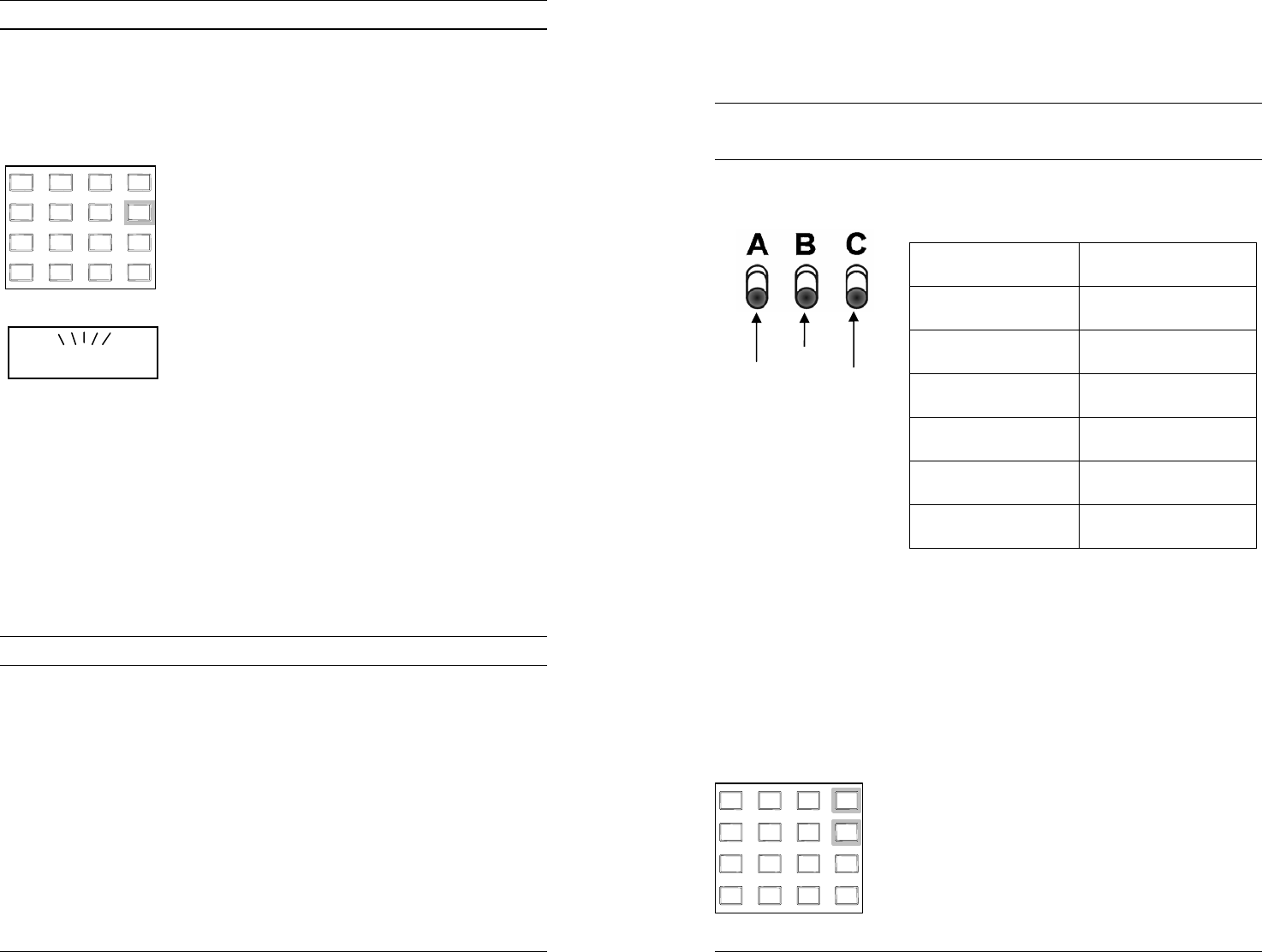
30 BK Radio
EMERGENCY CALL
Note: Emergency operation only applies to channels
programmed for Digital or Mixed Mode transmissions. If the
channel is programmed for Mixed Mode transmissions, the ‘TX
Digital’ switch must be ON.
To place an emergency group call, press and
hold the emergency button until the radio
beeps and the display flashes. On some
models, the emergency button may be the
[PRI] key. All scanning and priority scanning
functions will be disabled. If the radio is in
Unit-To-Unit Mode, that mode will be exited
and the radio will be placed in Emergency
Mode. Each subsequent press of PTT will
cause the radio to transmit on the knob-
selected channel with the emergency bit set,
indicating an emergency condition. If the
Channel Selector is changed, the Emergency
Mode will follow to the newly selected
channel. Cycle power to return the radio to
normal operation.
On channels programmed for analog
transmissions, and channels programmed for
Mixed Mode transmissions with the ‘TX Digital’
switch OFF, pressing PTT in Emergency
Mode will result in a normal analog
transmission.
USER SELECTED CHANNEL GUARD
When the radio is being programmed with transmit and receive
frequencies for each channel, a receive Channel Guard value and a
transmit Channel Guard value can also be assigned to each channel. If
User Channel Guard Selection is enabled, the Channel Guard values
for any channel can be copied to another channel in the radio. On
channels programmed for Analog operation only, the CTCSS or
CDCSS guard values will be copied. On channels programmed for
Digital operation only, NAC’s only will be copied unless the radio is
programmed to also copy the Talk Group ID (TGID), Mode (Digital,
Analog or Mixed) and Squelch setting (Normal or Selective). On Mixed
Mode channels, Analog or Digital values will be copied as needed.
1
2
3
4
5
6
7
8
9
0
*
#
CLR
FCN
PRI
ENT
LABE
L
DPH Owner’s Manual 15
If the group or channel is locked to a switch
position, pressing [#] will only display the pre-
programmed value. New entries will not be
accepted.
PROGRAMMABLE TOP SWITCHES/
FUNCTION MENU
The following functions can be assigned to the
three top switches or the keypad [FCN] key
menu:
FUNCTION FCN Key Menu Label
Low Power Select LO POR
Channel Scan ChN SCN
Priority Scan PRI SCN
Repeater Talk Around TRN DIR
Group Scan GRP SCN
Transmit Digital TX DIG
Your dealer can also assign more than one
function to the same top switch. For example,
both low-power select and RTA could be
enabled by the same switch.
NOTE: Assume for this Owner’s Manual
that Switch ‘A’ has been
programmed for TX Digital, Switch
‘B’ has been programmed for
Scan, and Switch ‘C’ has been
programmed for Priority Scan.
To access functions on the keypad [FCN] key
menu:
1. Press the [FCN] key to display the
function menu.
2. Repeatedly press [FCN] to step through
the menu.
1 2
3
4
5
6
7
8 9
0
*
#
CLR
FCN
PRI
EN
T
TX
Digital
Scan
Priority
Scan
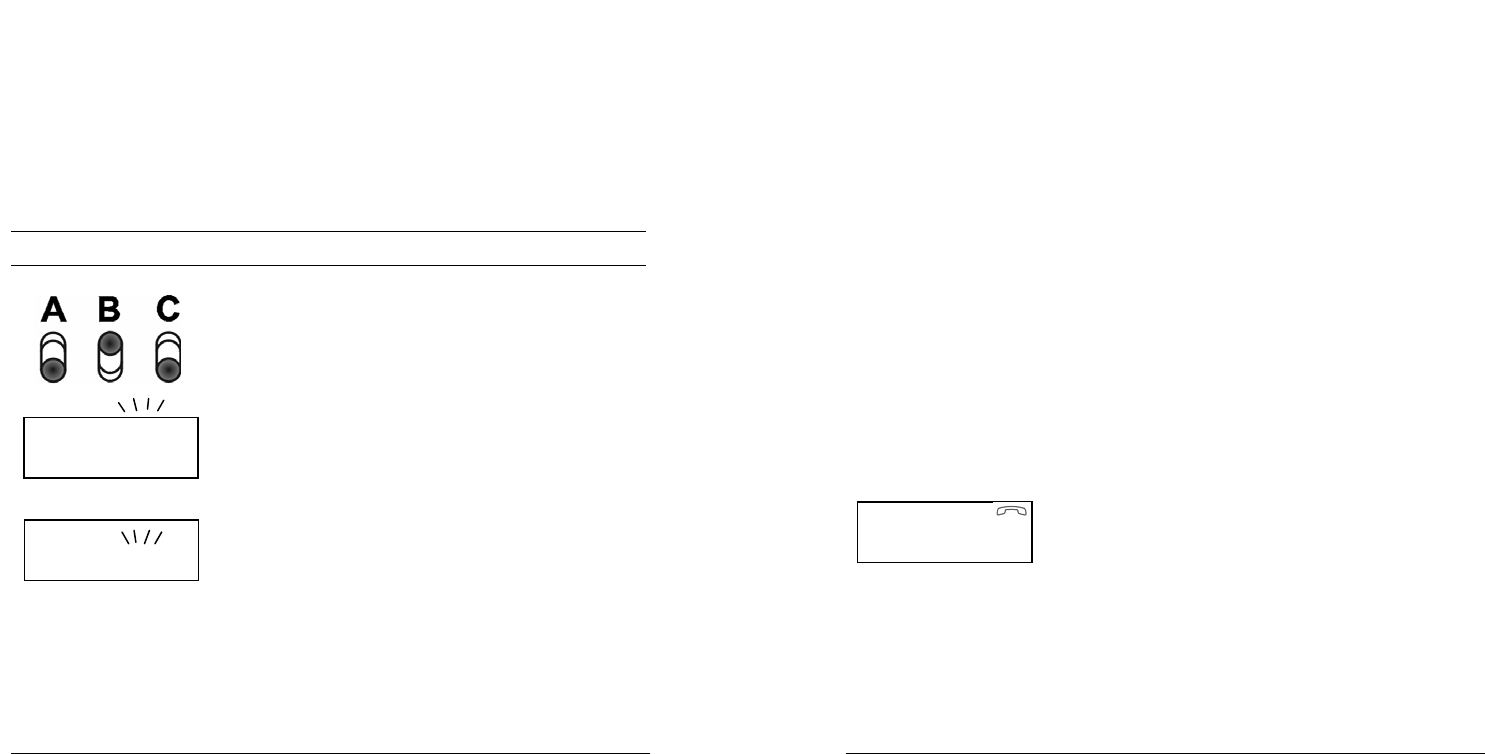
16 BK Radio
3. Press [PRI] to toggle the function on/off
when the desired menu item is displayed.
When the display flashes, the function is
enabled.
KEYPAD LOCK
To lock/unlock the keypad, press and hold the
[FCN] key.
LOCKOUT EXCEPTIONS:
1. If enabled, a long [PRI] key press will
activate Emergency Mode even when the
keypad is locked.
2. PTT unlocks the keypad during transmit
for DTMF key presses if the radio is
programmed for DTMF operation.
3. The keypad will be automatically unlocked
when Unit-To-Unit Mode is entered by
pressing PTT to respond to a Unit-To-Unit
call, when Unit-To-Unit callback is
enabled. The keypad will be re-locked
when Unit-To-Unit Mode is exited.
SCAN OPERATION
1. Slide Switch B (SCAN) up.
2. Slide Switch C (priority) down.
The display indicates scan operation by
flashing SCN or two flashing dashes at the
right side of the display if Numeric Display
Mode is selected.
Scan operates only while the radio is not
transmitting. The radio checks for signals on
channels in the preset Scan List, as well as
the channel selected by the Channel Selector
knob.
When a signal is detected, scanning stops and
the message is received. The received
channel is shown in place of the transmit
channel.
SCN
LABE
L
3
c
h
1
-
-
DPH Owner’s Manual 29
1. Press the [#] key to toggle a decimal on or
off to the right of the character in position
7. The decimal moves left with the number
in position 7 as new numbers are entered.
2. Use the following steps to enter a number
in position 8 or characters in positions 1-8:
a. Press the [PRI] key repeatedly to
cycle through characters 0-9, A-Z, -, *,
$, /, +, %, \, |, _, <, >, h, blank, then
back to the start again.
If you pass the desired character,
press the [PRI] key repeatedly until
you return to the start and reach that
character again.
b. Press the [FCN] key to shift the
display left by one position, leaving
position 8 blank.
c. Press the [PRI] key repeatedly to
enter the next character, or press the
[FCN] key a second time to enter a
blank space.
d. To abandon changes, press the [CLR]
key, restoring the original label.
e. Press the [ENT] key to store changes.
PROGRAMMING A NUMERIC ID
Press [ENT] to display the numeric ID. Press
[CLR] then enter the new ID (up to 7 digits).
Press [ENT] to store the new ID. Select a
new ID to be programmed, or press and hold
[ENT] to exit Programming Mode (the PRG
annunciator will be extinguished).
PRG ID
14
5
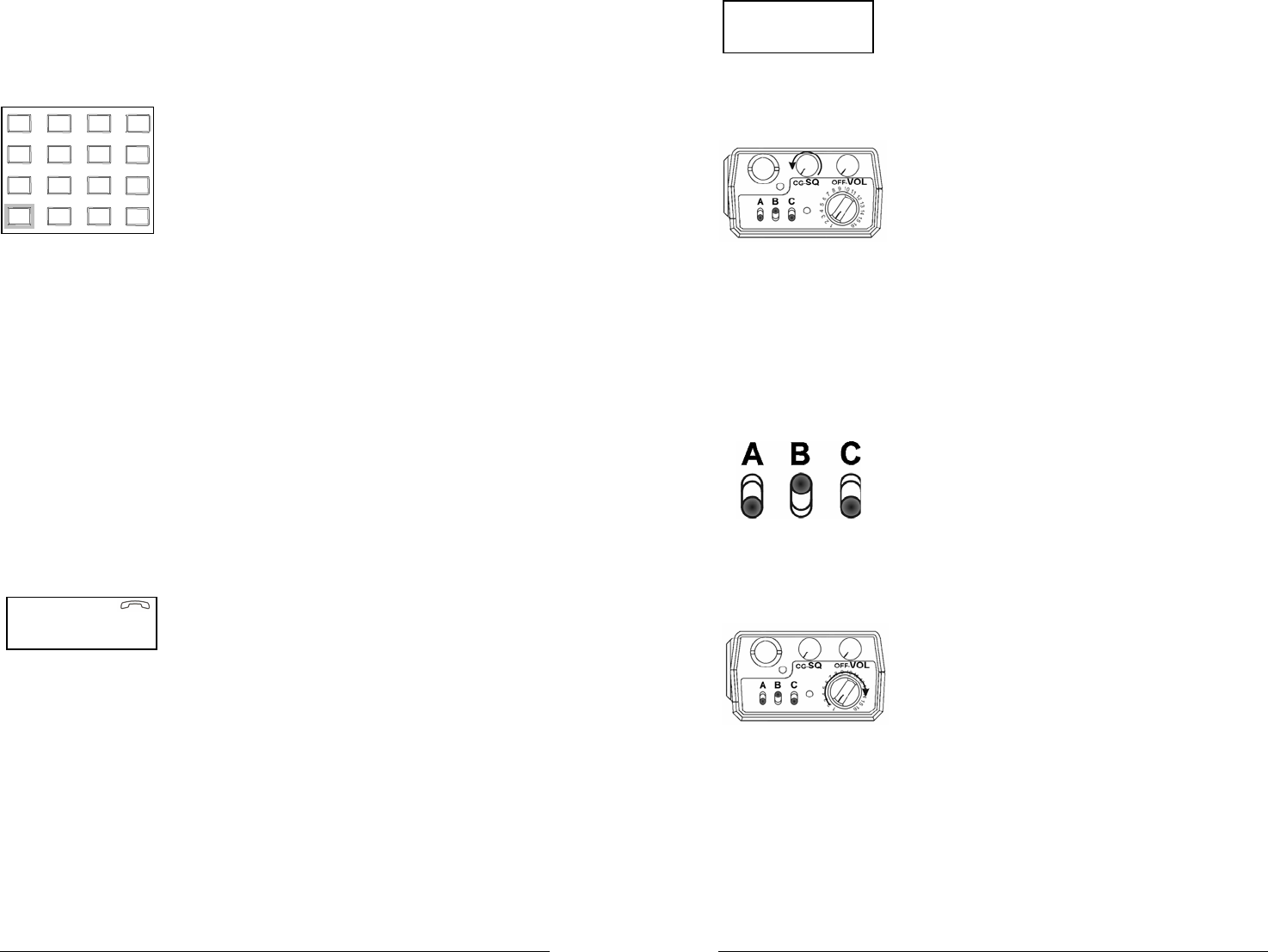
28 BK Radio
UNIT-TO-UNIT CALLBACK
If Unit-To-Unit callback is enabled, and a Unit-
To-Unit call is received on the Ready-to-
Transmit (RTX) channel, the user may press
PTT before the hold time expires, causing the
radio to enter Unit-To-Unit Mode and transmit
using the received ID as the destination ID. If
the callback timer expires before PTT is
pressed, the radio will return to normal
Operating Mode, but the phone icon will flash
until the [*] key is pressed, bringing up the last
active ID.
To exit Unit-To-Unit Mode, press and hold
the [*] key.
The callback timer can be cleared by making
the held channel invalid. For instance, if a
scan channel is being held, turn scan off.
PROGRAMMING UNIT-TO-UNIT CALL LIST
Press [*] to bring up the last active ID. If the
last active ID was a Call List ID, the ID’s label
will be displayed along with the phone icon.
Otherwise, the ID number will be displayed
along with the phone and ID icon.
Press a number key (0 – 9) to go directly to
the desired Call List ID, or press [PRI]
repeatedly to cycle to the label of the ID to be
re-programmed. Press and hold the [FCN]
key to enter ID Programming Mode (PRG icon
will be illuminated). As in keypad
Programming Mode, normal radio function will
be disabled until ID Programming Mode is
exited.
PROGRAMMING A LABEL
Press the [CLR] key. The display becomes
blank.
Press number keys to enter 0-9 in positions
1-7. The digits start in position 7, then move
left.
1
2
3
4
5
6
7
8
9
0
*
#
CLR
FCN
PRI
ENT
PRG
LABE
L
DPH Owner’s Manual 17
Once the signal ends, the radio continues to
monitor the channel for the preset scan delay
time before it resumes scanning.
SCAN CHANNEL GUARD CHANNELS
1. Slide Switch B (scan) up.
2. Turn the Squelch knob completely
counterclockwise, past the detent, to the
Channel Guard position.
When a signal is detected, scanning stops
while the radio checks for the proper Channel
Guard value. If the signal contains the proper
Channel Guard value, the radio receives the
message. Otherwise, the radio resumes
scanning immediately.
NUISANCE CHANNEL DELETE
If your radio is programmed for Nuisance
Channel Delete and Channel Scan is
assigned to a top switch (Switch B, for
example), a Nuisance Channel can be
temporarily removed from the Scan List by
sliding Switch B (scan) down momentarily and
then back up.
TRANSMIT WITH SCAN ON
When Switch B (scan) is up, the radio
transmits on the channel selected by the
Channel Selector knob unless Talkback Scan
is enabled or Priority Scan is enabled (see
Priority Scan operation).
1. Select a transmit channel by turning the
Channel Selector knob.
2. Press and hold the PTT switch and talk in
a normal voice.
When the PTT switch is released, the radio
continues to monitor the selected channel for
the preset scan delay time before it resumes
scanning.
RX SCN
LABEL
3
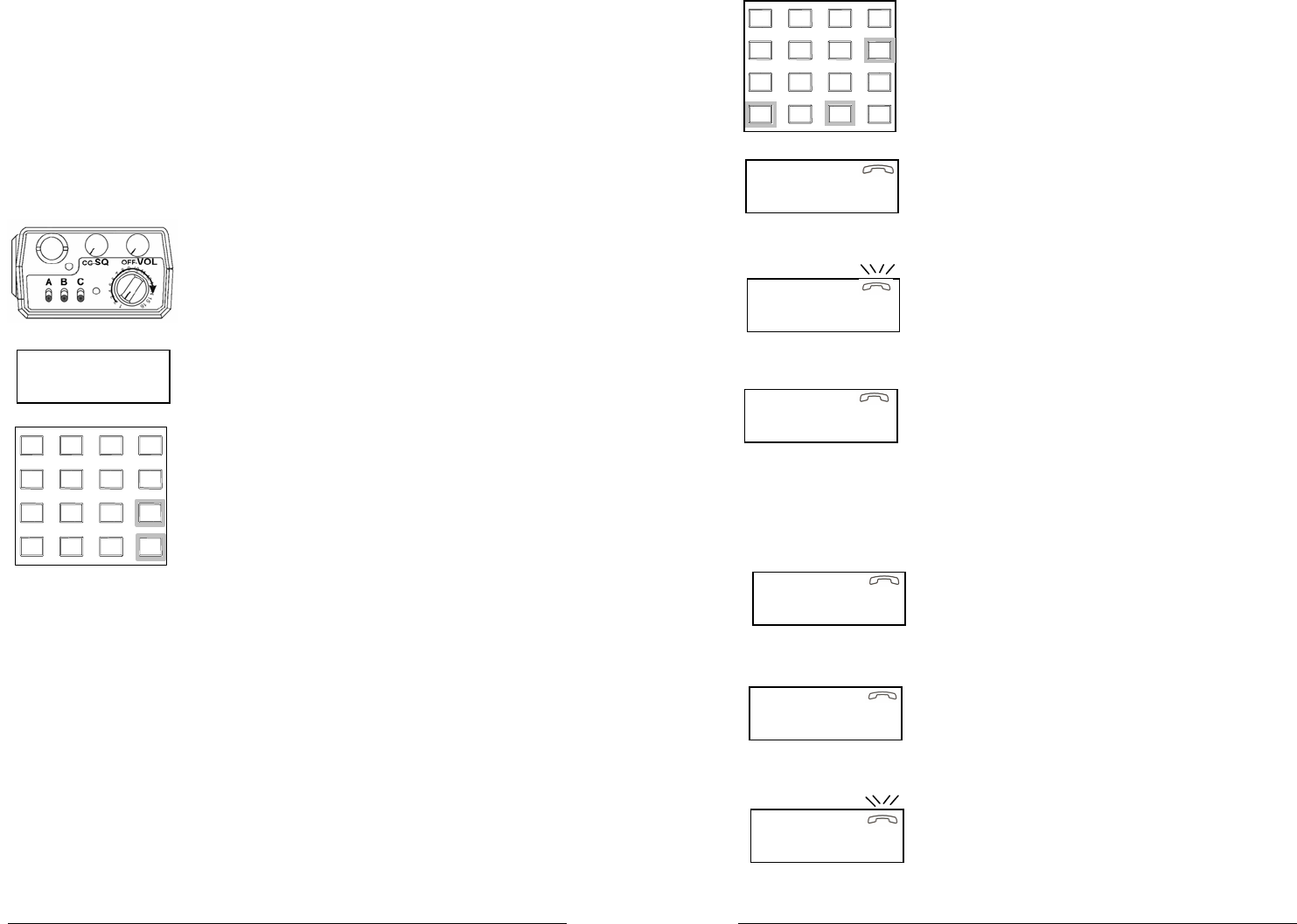
18 BK Radio
TALKBACK SCAN
If your radio is programmed for Talkback
Scan, press PTT while a channel is active or
while scan delay time remains. You will be
responding on the transmit frequency of the
received channel.
Talkback Scan will not work if Priority Scan is
also on and your radio is programmed to
always transmit on the Priority 1 channel.
CHANGE THE SCAN LIST
If the radio has not been programmed for
Scan List Lock, the user may add or remove
channels from the Scan List. If user changes
are enabled, follow these steps to change the
Scan List:
1. Slide Switches B (scan) and C (priority)
down.
2. Select a channel to be added or removed
from the Scan List by turning the Channel
Selector knob. If the channel is already on
the Scan List, SCN appears in the display.
3. Press the [ENT] key to add a channel to
the Scan List. A short beep sounds and
SCN appears in the display.
4. Press the [CLR] key to remove a channel
from the Scan List. A short beep sounds
and SCN disappears from the display.
GROUP SCAN
Channels on each “Channel Scan List” in
groups on the “Group Scan List” are scanned
sequentially. The selected group is always
scanned when Group Scan is enabled, even if
that group is not on the Group Scan List.
When Group Scan is enabled, the following
features are disabled:
• Priority Scan
• Dual Priority Scan
• User-Selected Channel Guard
• Nuisance Channel Delete
SCN
LABEL
1
2
1 2
3
4
5
6
7
8
9
0
*
#
CLR
FCN
PRI
ENT
DPH Owner’s Manual 27
INITIATING A UNIT-TO-UNIT CALL
To initiate a Unit-To-Unit call, press the [*] key
to enter Unit-To-Unit Mode. The label of the
last active (called or received) ID will appear
on the display.
If the last active ID was a Call List ID, its label
will be displayed along with the phone icon,
otherwise the numeric ID will be displayed
along with the phone and ID icon. If a label is
displayed, press and hold [#] to view the
corresponding numeric ID.
To place a call to the displayed unit, press
PTT. To choose another unit, use the keypad
to enter the desired call list entry (0 - 9), or
press [PRI] repeatedly to cycle through all call
list entries, or press [#] to manually key in a
new ID (up to 7 digits). To re-select the ‘last
active’ ID, press the [*] key. Once the new
unit ID is selected or entered, press PTT to
place the call.
To exit Unit-To-Unit Mode, press and hold
the [*] key.
RECEIVING A UNIT-TO-UNIT CALL
When a Unit-To-Unit call is received while the
radio is in normal Operating Mode, the radio
will beep twice. The display will show the ID
of the calling unit. If the ID matches one of the
Call List IDs, the associated label will be
displayed along with the RX and phone icons.
Otherwise the numeric ID will be displayed
along with the RX, phone, and ID icons. The
calling unit’s ID will be displayed for the
duration of the reception, and once the signal
goes away, for a programmed hold time.
When the hold time expires, the display will
return to the normal Operating Mode display,
but the phone icon will flash until the [*] key is
pressed, putting the radio in Unit-To-Unit
Mode, displaying the last active ID.
1
2
3
4
5
6
7
8
9
0
*
# CLR
FCN
PRI
ENT
LABE
L
Last Active Was Unit
On Call List
ID
<
Prompt For
Manual ID Entr
y
RX
LABE
L
Incoming Call From
Unit
O
n
Call List
ID
14
5
Last Active Was Unit
Not On Call List
C
H
5
Missed Call
Incoming Call From
Unit Not On Call List
RX ID
14
5
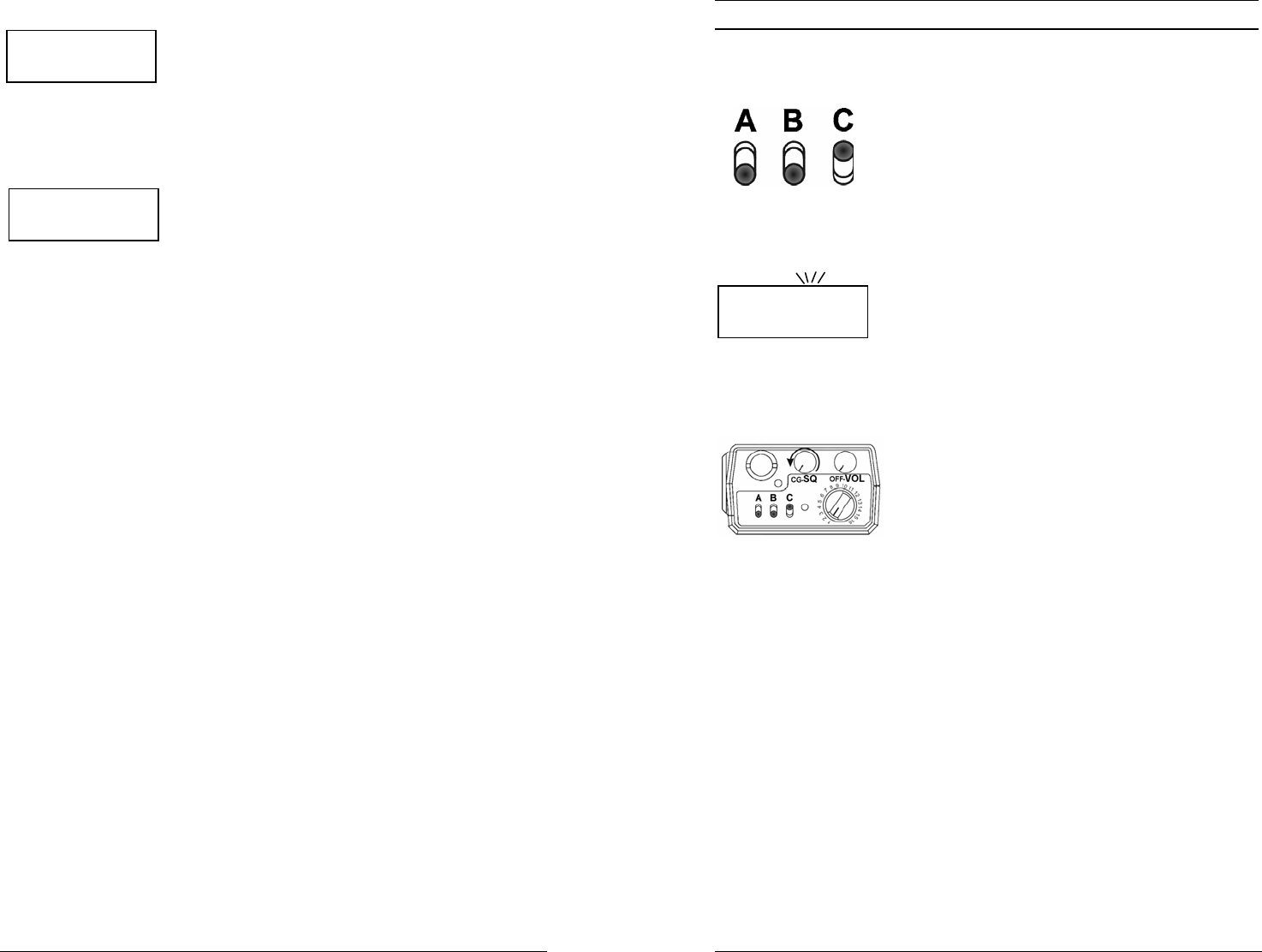
26 BK Radio
If the calling unit is not the same unit
displayed before the call was received, the
calling unit’s ID will be displayed for the
duration of the reception. The previously
displayed ID will remain the default transmit
ID, but the interrupting ID will be captured as
‘last active’.
To speak to the interrupting caller, press [*] to
make the last active ID the new default
transmit ID. When a group call (or, if allowed,
an analog signal) is received, the radio will
display the RTX channel’s label for the
duration of the reception.
If the RTX channel’s Digital Squelch Mode is
set to ‘normal’, the radio performs as when the
Squelch Mode is ‘selective’, except all
individual calls will be received when the
incoming NAC matches the channel’s
programmed receive NAC, not just individual
calls addressed to the unit. Individual calls not
addressed to the unit will be indistinguishable
from group calls. Only the channel label will
be displayed, not the ID of the calling unit.
If Unit-To-Unit Mode is entered when the RTX
channel is programmed for analog-only
transmissions, pressing PTT will cause the
radio to beep until PTT is released. The user
must select a channel capable of digital
transmissions before placing a Unit-To-
Unit call. If the RTX channel is programmed
for Mixed Mode transmit, transmissions will be
made as digital Unit-To-Unit calls while the
radio is in Unit-To-Unit Mode.
Incoming
Group Call
RX ID
C
H
5
RX
C
H
5
Incoming
Analog Call
DPH Owner’s Manual 19
PRIORITY SCAN
Priority Scan enables the radio to receive on
any channel while monitoring for a message
on the designated priority channel(s). The
radio samples each priority channel at a
preset rate (.25-2.0 seconds) regardless of
activity on any other channel. Priority Scan
operates only while the radio is not
transmitting and can be used in combination
with scan operation.
When Switch C (Priority) is up, the display
flashes SCN. If a message is received on a
priority channel, the Priority Indicator lights,
and the radio receiver locks onto that channel
for the duration of the transmission, unless a
higher priority channel interrupts.
Priority Scan can be used in combination with
Channel Guard with:
• Switch C (Priority) up
• The Squelch knob in the Channel Guard
position (fully counterclockwise detent
position) and
• The Priority Channel(s) programmed with
Channel Guard
If a message is received on a priority channel,
the radio receiver locks on to the priority
channel and checks to see if the proper
Channel Guard value is present. If the signal
contains the proper Channel Guard value, the
radio receives the message. Otherwise, the
radio will re-check the channel every 4
seconds, until the activity on the channel
ceases.
DUAL PRIORITY SCAN
In each group, up to two of the 16 channels
can be designated as priority channels.
These two, PR1 and PR2, are periodically
tested for activity, even if a different
transmission is being listened to. Activity on
PR2 preempts activity on any of the non-
PR SCN
LABEL
3
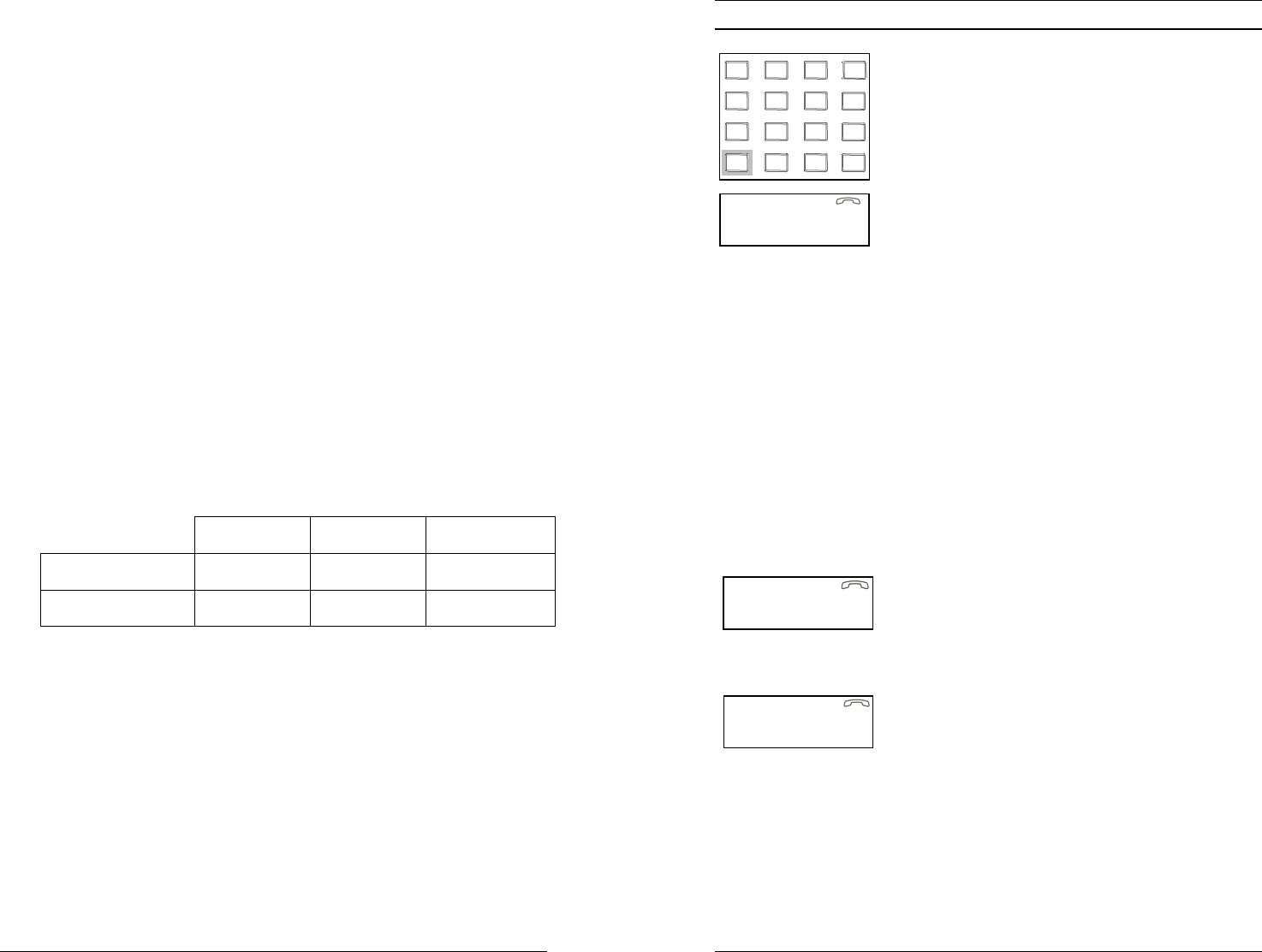
20 BK Radio
priority channels. Receptions on PR1 have
priority over any other channel in the group,
including PR2.
Either priority channel can be programmed as
a fixed channel, tied to the Channel Selector
knob, or programmed OFF. If the radio is
programmed to transmit on the first priority
channel, transmissions will occur on PR1
when operating in Dual Priority Scan Mode.
If PR1 is a fixed channel, and the [PRI] key is
not locked out, the user can move the channel
selector to a new channel and press the [PRI]
key to choose a new PR1 channel.
Dual Priority Scan is automatically disabled
when Group Scan is on.
OLD-STYLE BK PRIORITY SCAN
The radio can be programmed with one of
three Priority Modes: A, B, or C. The table
below shows how the priority channels and
the transmit channels are selected in each
mode.
Mode A Mode B Mode C
Priority Channel Channel Knob Preset Preset
Transmit Channel Channel Knob Channel Knob Priority Channel
DPH Owner’s Manual 25
UNIT-TO-UNIT CALL
P25 Unit IDs allow for Unit-To-Unit calls when
the radio is operating in Digital Mode. To view
the radio’s ID, press and hold the [*] key while
not in Unit-To-Unit Mode. (Unit-To-Unit Mode
is indicated by a phone icon in the upper right
corner of the display). Channels programmed
for analog only operation will not be able to
transmit or receive Unit-To-Unit calls.
UNIT-TO-UNIT MODE
When the radio is in Unit-To-Unit Mode, all
scanning functions will be disabled. The radio
will receive and transmit on the Ready-to-
Transmit (RTX) channel only. Depending on
programming, the RTX channel can be the
main channel, a held scan or priority channel if
Talkback Scan is enabled, or the Priority 1
channel if TX on PR1 is enabled. To alert the
user that the radio is in Unit-To-Unit Mode, a
beep will periodically sound until the unit is
returned to normal Operating Mode.
If the RTX channel’s Digital Squelch Mode is
set to ‘selective’, the radio will accept group
calls, correctly addressed Unit-To-Unit calls,
and if RX Mode is set to mixed, analog
signals.
When a correctly addressed Unit-To-Unit call
is received, the radio will beep twice. If the
calling unit’s ID matches one of the Call List
IDs, the associated label will be displayed
along with the RX and phone icon. Otherwise,
the numeric ID will be displayed along with the
RX, ID, and phone icon.
1
2
3
4
5
6
7
8
9
0
*
#
CLR
FCN
PRI
ENT
Incoming Call From
Unit on Call List
RX
LABE
L
Incoming Call From Unit
Not on Call List
RX ID
14
5
ID
78
5
Radio Unit ID
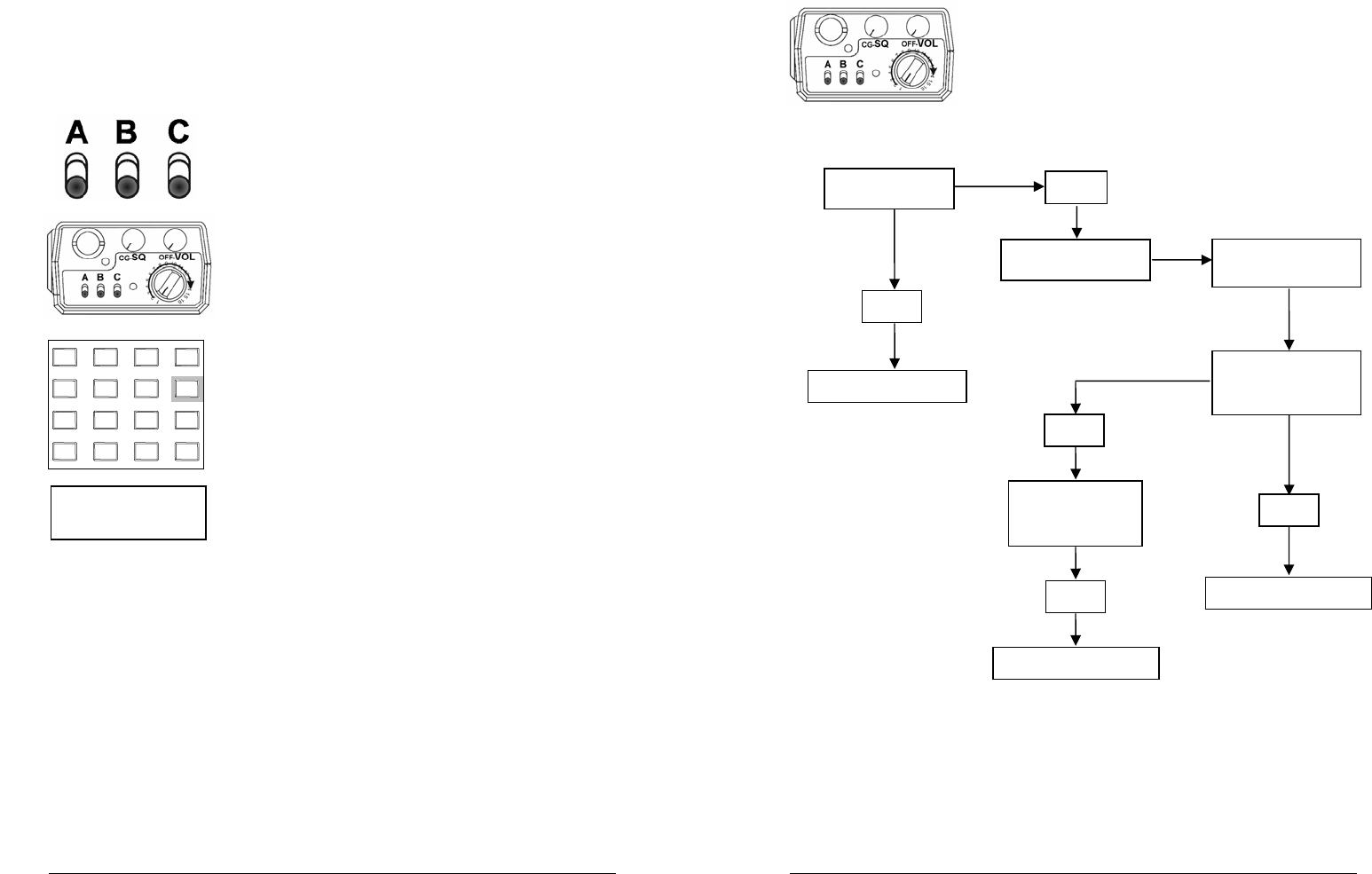
24 BK Radio
To reply to a message on the priority channel,
press the PTT switch. The radio transmits only
on the priority channel when Switch C
(priority) is up. Once activity has ceased on
the priority channel, the radio returns to scan
operation.
CHANGE THE PRIORITY 1 CHANNEL
The fixed Priority 1 channel can be
permanently set or can be changeable. If the
radio has a changeable priority channel, use
the following steps to make this change:
1. Slide Switches B (scan) and C (priority)
down.
2. Turn the Channel Selector knob to the
channel you want to enter as the new
Priority 1 channel.
3. Press the [PRI] key. A short beep sounds
and PR appears in the display, indicating
that the displayed channel is now the
Priority 1 channel.
NOTE: If the radio is programmed for Dual
Priority operation, only the Priority 1
channel can be changed with the
[PRI] key.
NOTE: A channel can be the priority
channel even if it is on the Scan
List. Due to multiple sampling of the
same channel, however, maximum
performance occurs when the
priority channels are not on the
Scan List.
PR
LABEL
3
1
2
3
4
5
6
7
8
9
0
*
#
CLR
FCN
PRI
ENT
DPH Owner’s Manual 21
Does PR appear
in the display?
No
Priority Mode A
Yes
Turn channel knob
to different channel. Slide Switch C up
Does display show
knob-selected
channel?
No
Does display
change to priority
channel?
Yes
Priority Mode C
Yes
Priority Mode B
WHICH MODE IS INSTALLED?
If the radio has a display and keypad, follow
these steps to determine which Priority Mode
is programmed:
1. Slide Switches B (scan) and C (priority)
down.
2. Turn the Channel Selector knob, stopping
at each channel to view the LCD display.
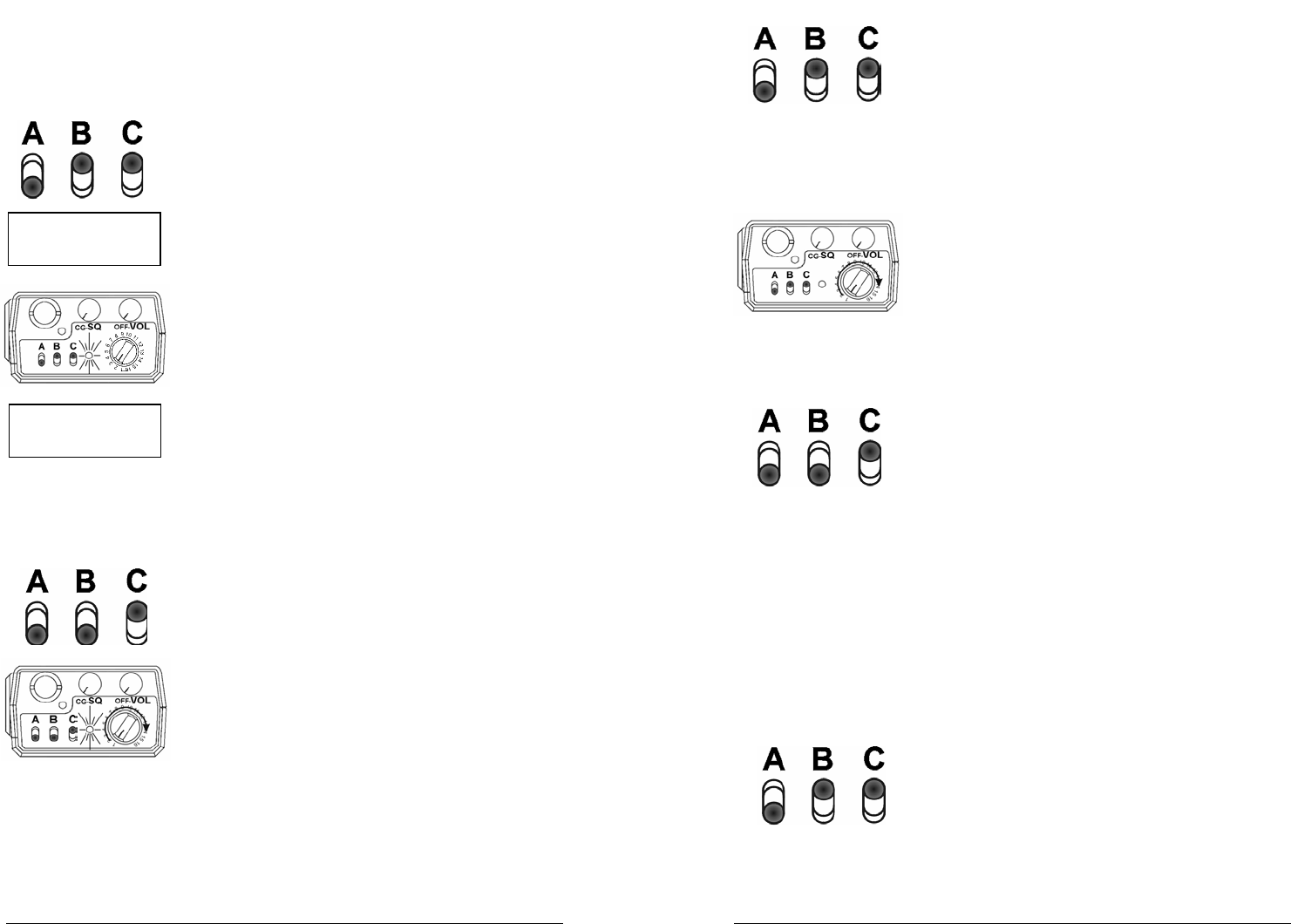
22 BK Radio
Priority Mode A With Scan
In Priority Mode A, the priority channel is set
by the Channel Selector knob. Priority Mode A
is seldom used by itself because the radio
receives and transmits only on the knob-
selected channel.
When Switches B (scan) and C (priority) are
up, scanning occurs until an active scan
channel is found. The radio receives the
message while continuing to check the priority
channel. The display shows the scan channel.
If the priority channel becomes active during
this message, the Priority Indicator will light.
The radio changes to the priority channel and
holds for the duration of the message. The
display shows the priority channel.
To reply to a message on the priority channel,
press the PTT switch and the radio will
transmit on the priority channel. Once activity
ceases on the priority channel, the radio
returns to scan operation.
Priority Mode B
With Switch C (priority) up and Switch B
(scan) down, the radio can receive on the
knob-selected channel while sampling the
priority channel. If the priority channel
becomes active, the Priority Indicator lights
up. The radio changes to the priority channel
and holds for the duration of the transmission.
To reply to a message on the priority channel,
turn the Channel Selector knob to the priority
channel, and then transmit.
PR RX SCN
LABE
L
1
2
PR RX SCN
LABE
L
3
DPH Owner’s Manual 23
Priority Mode B with Scan
With Switches B (scan) and C (priority) up, the
radio scans until it locks on to an active
channel. The radio continues to sample the
priority channel while listening to the active
scan channel.
If activity occurs on the priority channel, the
radio overrides the active scan channel,
changes to the priority channel, and holds for
the duration of the transmission.
To reply to a message on the priority channel,
turn the Channel Selector knob to the priority
channel, and then transmit. Once activity has
ceased on the priority channel, the radio
returns to scan operation.
Priority Mode C
With Switch C (priority) up and Switch B
(scan) down, the radio samples the fixed
priority channel at the preset rate. If activity
occurs on the priority channel, the radio
changes to the priority channel and holds for
the duration of the transmission.
To reply to a message on the priority channel,
press the PTT switch. The radio transmits only
on the priority channel when Switch C (priority)
is up. Once activity has ceased on the priority
channel, the radio returns to the receive
channel on the Channel Selector knob.
Priority Mode C with Scan
With Switches B (scan) and C (priority) up, the
radio scans until it locks on to an active
channel. The radio continues to sample the
priority channel while listening to the active
channel. If activity occurs on the priority
channel, the radio overrides the active scan
channel, changes to the priority channel, and
holds for the duration of the transmission.